#winner of the tour de france is among the best in the world
Explore tagged Tumblr posts
Text
Bikeflights Becomes Tour De France Femmes Avec Zwift Official Service
Each summer, we eagerly await the start of the Tour de France, and more recently also the Tour de France Femmes avec Zwift. With every day’s stage, there’s the potential for excitement as the world’s best road racers vie for the glory of stage victories and the coveted maillot jaune (yellow jersey) of the overall race winner. So we couldn’t be more excited to announce that Bikeflights is now also a Tour de France Femmes avec Zwift Official Service.

“We’re pleased to extend Bikeflights’ relationship with Amaury Sport Organisation (A.S.O.) to both continue our support for the Tour de France and also expand it to include the Tour de France Femmes avec Zwift,” said Sue George, Vice President of Bikeflights.
Bikeflights has long been a supporter of women’s cycling, from its grassroots-focused Ambassador program that has helped many female riders to its sponsorship of elite and junior individual cyclists and cycling teams.
“It’s exciting to be a part of the growth of women’s professional cycling, and we hope to encourage future generations of aspiring young women who dream of competing in cycling’s most iconic event,” said George.
Bikeflights began working with Amaury Sport Organisation through a licensing deal signed in 2019 that designated Bikeflights as an official bike shipping service of the Tour de France. At the time, there was no women’s edition of the race.
The renewal designates Bikeflights as an official service of both the Tour de France and the Tour de France Femmes avec Zwift. Per the three-year agreement extension, Bikeflights will collaborate with Amaury Sport Organisation to promote Bikeflights’ global bicycle shipping service among fans of the Tour de France and some L’Etape events.
Bikeflights offers a fast, convenient service for cyclists to ship their bikes to and from France. After booking their bike’s shipment with Bikeflights, cyclists can travel unencumbered by their bikes through airports en route to their destination. Their bike will be awaiting them upon arrival, just like happens for the pros.
#bikeflights#bikeshipping#weshipyouride#shipyourbike#eventshipping#bicycleshipping#tour de france#tour de france femmes
0 notes
Text

#Hans Junkermann one of the best cyclists in the world#winner of the tour de france is among the best in the world#health & fitness#motivation
0 notes
Text
BEST THINGS TO DO AT MEDELLÍN 🇨🇴🌄
By Laura García, Samuel Galvis and Susana Carmona ⭐

(picture: Medellín Advisor)
Medellín is the capital city of the department Antioquia, in Colombia. Nicknamed "City of Eternal spring 🍂" for its weather.
Prepare your bags because here we'll show you the best things you may do in Medellín ✈️🧳
INTELECTUAL EXPERENCIES
Museo el Castillo (Castle Museum) 🏰
It's located on El Poblado, it's a ghotic medieval castle, built by the architect Nel Rodríguez circa the 30's, it's similar to some constructions on France, it has gardens on a french style, libraries and expositions rooms where you can find out how was the life of the family that used to live there. In 1971 the owner's (Diego Echavarría) wife donated the castle to Medellín's cultural heritage.
El castillo museum has guided tours. It also counts with an art school, with courses where you'll learn about the importance of culture.
Picnics can be done in the museum's gardens with previous reservations.
Collections on the castle are change frecuently, in Christmas you're going to find out amazing christian mangers expositions.
Permanent exposition are divided in 9 rooms:
Luis XV room
Music room
Colonial room
Entrance hall
Gobelins room
Don Diego's bedroom
Isolda's bedroom
Doña Dita's bedroom
Memories room

(picture: Sistema de bibliotecas públicas Medellín)
Planetario and Explora 🌎✨
Best experience for science lovers.
Planetario Jesus Emilio Ramírez and Parque Explora are located in Carabobo norte, next to universidad de Antioquia.
Planetario de Medellín it's a place for educational heritage, made for astronomy and space students or fans, it counts with two floors of science Experiences, including geology, astrophysics, quantum mechanics, relativity and astrobiology, a 4k dome, where are daily projected different Functions, including the worlwide function "Life's question" winner of diverse awards. It also serves as auditorium for expositions on topics like biology, physics, quantum mechanics that are done by local and international academics.
Parque explora is an intercative science museum, it has the largest aquarium in Latin America, with aquatic fauna and Flora from all over the country. The museum contains over 300 interactive experiencies divide in 5 expositions:
Mind room
Music room
On scene room
Time room
Dinosaurs exposition
Both has programs and courses for all the year, you'll find
El cielo está noche (this nights sky)
Exploratorio
Sci-fi club
Science colloquiums
Courses
Astronomical observations
Among others

(picture: Carlos Tobón, parque explora)
ART EXPERIENCIES 🎨
Filarmónica Medellín's concerts 🎶
the most innovative orchestra in the world.
Filarmed does concerts frecuently, for example, recently it did a electronica concert, doing covers of artist like avicci, David Guetta, Coldplay, sia, commemorating Earth's day, you can find information about next concerts in filarmed (on IG)

(picture: caracol radio)
GASTRONOMICAL EXPERIENCES 🍛🥑
Sooo in this section you're going to find out the best of paisa food. Gastronomy antioqueña Extends to the cafetera region, among the most common plates you'll find the use of pork, avocado, yuca, beans, arepa and maiz (corn), [you'll find out all of them in a principal plate: bandeja paisa] also in a tipic panadería you'll find a great variety of parva, including pandequeso, pandeyuca, and of course, best thing you are going to eat in you life: buñuelos, for a desert you can try solteritas, and you'll find out that a tipical paisa eats all of the previous items with mazamorra.
You'll find out paisas' tipical food in:
El rancherito
Hato viejo
Doña rosa
But if you want to try worlwide gastronomy you can find very good restaurants in Calle primavera (el Poblado) there are options for everyone 👍

EXPERIENCES TO CONNECT WITH NATURE 🌄
Parque arví 🚡
Parque arví it's an ecological park located in Santa Elena, there are native forests and interactive experiencies such as Comfama adventure's experience, also you can do ecological walks or find out about Santa Elena local gastronomy and products

(picture: Viajes Escapados)
TRANSPORTATION 🚇
Metro Medellín
Metro de Medellín crosses área metropolitana, Medellín is the only city on Colombia that has metro.
Metro de Medellín offers diferents services such as:
Metro plus
Alimentadores
Metro cable
Metro
All services are accessible with cívica ID.

(picture: RTVC noticias)
Visit Medellín! :) 🌄
5 notes
·
View notes
Text
Oscars 2021 Predictions and Analysis of Frontrunners
https://ift.tt/3s3HJE1
Perhaps the most surprising thing about the Oscars 2021 nominations is how unsurprising they were. There were course a handful of snubs, from One Night in Miami and Ma Rainey’s Black Bottom being left out of the Best Picture category to LaKeith Stanfield surprising awards watchers with a Best Supporting Actor nod thanks to Judas and the Black Messiah (displacing Chadwick Boseman from Da 5 Bloods). But by and large? Things proceeded the way prognosticators pretty much expected.
With the Academy of Motion Picture Arts and Sciences picks in, we can see that David Fincher’s Mank is the technical favorite with below the line voters, pushing the Netflix deconstruction of Golden Age Hollywood to eight nominations. These include major nods for Picture, Director and Best Actor (Gary Oldman) and Best Supporting Actress (Amanda Seyfried), but also a lot of technical recognition too in Cinematography, Production Design, Costume, and Makeup and Hairstyling.
Even so, the obvious frontrunner remains Chloé Zhao’s Nomadland, a beautiful film that turns the tragedy of the Great Recession into a bittersweet celebration of American Nomad culture. The Searchlight Pictures release garnered six nominations, including Zhao in the Best Director category and another for Best Picture. Zhao’s directing nod, alongside Emerald Fennell for Promising Young Woman, additionally made history with this being the first time two women were nominated in the Best Director category in the same year.
Meanwhile fans still mourning Chadwick Boseman’s tragic loss, as well as celebrating his tour de force final performance in Ma Rainey’s Black Bottom, can take some small comfort in the actor being the heavily favored contender in the Best Actor category.
In the end, things proceeded more or less as how the breathless awards race media class hoped it would. All of which raises an interesting question: Will there be any actual surprises then on Oscar night? Well… below is our best, and entirely too early, guess at what will win Best Picture and the other major categories. Be sure to check back here on Oscar night to remind us how wrong we were.
Just for clarity, nominees we want to win will be italicized while the ones we think will win will be bolded. When they’re one in the same, one contender will be italicized and bolded.
Best Picture
The Father Judas and the Black Messiah Mank Minari Nomadland Promising Young Woman Sound of Metal The Trial of the Chicago 7
I’m not sure I can think of a year with a more clear cut and inevitable frontrunner than Nomadland in 2021. There have been other years with dominant frontrunners—almost every year in fact—including several that go on to win, such as Green Book just two award seasons ago. However, there is almost always a counter-narrative that threatens the perceived frontrunner. Sometimes those whisper campaigns unseat the presumptive winner (see La La Land and 1917), and sometimes they don’t. But in the case of Chloé Zhao’s Nomadland there isn’t even a serious challenger.
This in part because Zhao made an extraordinary film which uncannily mixed documentarian filmmaking and its study of real-life American Nomads with narrative storytelling. It’s a trick Zhao has done several times before, including memorably with the Independent Spirit Award winner, The Rider. But here it is done with Oscar favorite in star Frances McDormand, and it draws attention to a whole culture of forgotten (white) Americans. Additionally, Nomadland is opening in a pandemic year where most of the more traditional awards contenders have vacated. The ones that haven’t are mostly being produced by Netflix, including The Trial of the Chicago 7 and Mank. The former might be a real contender for Best Picture under different circumstances, but the Academy is notoriously recalcitrant toward awarding Best Picture to Netflix originals and other streaming efforts. Just ask Roma for more.
Nomadland braved a small theatrical debut ahead of its premiere on Hulu, supporting the theatrical experience during COVID, while Chicago 7 was snubbed a Best Director nomination, suggesting there is some skepticism toward the film among a large wing of Academy voters. Mank, meanwhile, is an acquired taste that appeals to my personal sensibility. But it’s quite cold and less a love letter to the movie industry than a loving middle finger. That fact will probably hurt it in a number of categories, including Best Original Screenplay where it was snubbed today.
Best Director
Thomas Vinterberg, Another Round David Fincher, Mank Lee Isaac Chung, Minari Chloé Zhao, Nomadland Emerald Fennell, Promising Young Woman
While I would vote another way for Best Picture, I am totally onboard with seeing Zhao pick up the Best Director plaudit. Hers is an entirely unique cinematic voice that has successfully blurred the lines of how narrative filmmaking can be conveyed, and she’s done so while cultivating a great sense of empathy in Nomadland. The picture that finds beauty and resilience in a story that could’ve been a tragedy, memorializing the Americans left behind by the Great Recession.
Her groundbreaking techniques make her stand out in her field. Plus, Academy will be acutely self-conscious this year about the disappointing fact that only one other woman, Kathryn Bigelow, has won a Best Director Oscar. So be prepared for Zhao to make that two.
Best Actress
Viola Davis, Ma Rainey’s Black Bottom Andra Day, The United States vs. Billie Holiday Vanessa Kirby, Pieces of a Woman Frances McDormand, Nomadland Carey Mulligan, Promising Young Woman
Carey Mulligan is phenomenal in Emerald Fennell’s Promising Young Woman. Acerbic but devastating, guarded but vulnerable, and equal parts righteous and occasionally terrifying, she provides a multifaceted turn unlike anything else we’ve seen from the now twice-nominated actor. Previously she was recognized for her ingénue breakout in An Education, but now as an adult thespian, she’s a true revelation. That narrative will appeal to Academy voters, especially as they tend to favor younger actresses in the lead category. Frances McDormand is a famous exception to that rule, but McDormand has two Oscars already, and one is for Three Billboards Outside Ebbing, Missouri from only three years ago. Also Mulligan is much more keen on playing the awards season campaign game.
Admittedly, Andra Day won for Best Actress in a Drama at the Golden Globes … but the Globes are always going to be their own thing (ask Jodie Foster for more). And while Day is wonderful in The United States vs. Billie Holiday, that movie’s more meager quality is going to be an albatross.
Best Actor
Riz Ahmed, Sound of Metal Chadwick Boseman, Ma Rainey’s Black Bottom Anthony Hopkins, The Father Gary Oldman, Mank Steven Yeun, Minari
In his final performance, Chadwick Boseman is heartbreaking and utterly riveting. All strained bravado and barely masked desperation, his Levee is cool to a tragic fault in Ma Rainey’s Black Bottom. The film he occupies, based on the August Wilson play of the same name, enjoys its contrasts about Black artists navigating white dominated industries. But while Viola Davis’ charismatic turn is above the title, the B-side to her story as embodied by Levee is where the film’s ghosts wait. And they stayed with me long after the Netflix film ended.
Read more
Movies
How Chadwick Boseman Created His Final Performance in Ma Rainey’s Black Bottom
By Don Kaye
Movies
Promising Young Woman: Director Emerald Fennell Breaks Down the Ending
By Rosie Fletcher
Boseman deserves a posthumous Oscar for his turn—which would make him only the third performer to win one after Peter Finch for Network and Heath Ledger for The Dark Knight—and he’ll almost certainly get it on Oscar night.
Best Supporting Actress
Maria Bakalova, Borat Glenn Close, Hillbilly Eleg Olivia Colman, The Father Amanda Seyfried, Mank Youn, Yuh-jung, Minari
Conventional wisdom says Olivia Colman will win Best Supporting Actress for The Father. The Academy certainly likes her, having awarded her Best Actress two years ago for The Favourite, and the Academy also has a history of being more lenient on relative back-to-back Oscars in the Supporting category, unlike the historical precedents in the leading actor categories. However, I’m taken by the relative lack of consensus-building around Colman to date. Granted the Golden Globes denied Colman in favor of Jodie Foster, whose performance wasn’t even recognized by the Oscars this year. But the Critics Choice Awards also overlooked Colman while providing Maria Bakalova with a surprise win for Borat: Subsequent Moviefilm.
Precedent should still make me wary of picking Bakalova to win the award. After all, it’s a comedic performance which the Academy usually shies away from. However, this comedic turn was so good, it was able to expose Rudy Giuliani to be a creep with his hand down his pants in front of the world. That will appeal to Academy voters, especially after a year like 2020. Meanwhile my personal choice—Amanda Seyfried’s understated but wholly authentic restoration of Marion Davies’ image after Citizen Kane—may suffer from just a general apathy toward that film’s demeanor, at least from above the line voters. Her snub by her peers at the SAG Awards unfortunately speaks poorly of her chances.
Best Supporting Actor
Sacha Baron Cohen, The Trial of the Chicago 7 Daniel Kaluuya, Judas and the Black Messiah Leslie Odom Jr., One Night in Miami Paul Raci, Sound of Metal LaKeith Stanfield, Judas and the Black Messiah
Daniel Kaluuya’s performance in Judas and the Black Messiah is a sweltering achievement. With limited screen time—despite being the ostensible messiah of the film’s title—Kaluuya is searing as the Black Panther Party Chairman who created the Rainbow Coalition and was hounded to his death by the FBI through illegal means. I’m also partial to Sacha Baron Cohen’s turn in The Trial of the Chicago 7 where he showed a more sardonic range as a counterculture activist in the Windy City. But even I’ll concede his performance isn’t the one folks will probably be quoting for years to come.
Best Original Screenplay
Judas and the Black Messia Minari Promising Young Woman Sound of Metal The Trial of the Chicago 7
Traditionally the Screenplay categories are where Academy voters tend to recognize the more challenging outside-the-mainstream Best Picture nominees they don’t want to give the top prize to. Ergo, it’s a great place for Emerald Fennell to pick up an award for Promising Young Woman. The movie is too candy colored bleak and light hearted in its tragedies to garner enough Academy support in Best Picture, but its originality will be awarded here.
Best Adapted Screenplay
Borat 2 The Father Nomadland One Night in Miami The White Tiger
I suspect the love for Nomadland will continue in the Adapted Screenplay category with Zhao picking up another Oscar. While the screenplay is quite brilliant, I personally feel the movie’s greater achievement is in its visual storytelling and melding of real stories with a broader fictional narrative. Whereas Kemp Powers’ adaptation of his own play is magnificent. There is a fair criticism to be made that Powers couldn’t fully escape the stageniess of his original conceit about spending a night in a motel room with Malcolm X, Muhammad Ali, Sam Cooke, and Jim Brown. But the acute intelligence of his dialogue, and the way it cuts to the tensions of Black responsibility juxtaposed with soft American power, is as potent as it is finally exciting.
Best Cinematography
Judas and the Black Messiah Mank News of the World Nomadland The Trial of the Chicago 7
I suppose I’m predicting a sweep for Nomadland, which in some ways will be earned. In others it may not, such as if Sean Bobbitt’s cinematography in Judas and the Black Messiah.
Best Film Editing
The Father Nomadland Promising Young Woman Sound of Metal The Trial of the Chicago 7
Film editing should be the one category Aaron Sorkin’s The Trial of the Chicago 7 has locked up. With a breathless pace executed in nervy style by Alan Baumgarten, The Trial of the Chicago 7 makes dialogue exchanges out to be as exciting as any special effects-heavy set piece.
Best Costume Design
Emma. Mank Ma Rainey’s Black Bottom Mulan Pinocchio
I suspect Costumes will be one area where Ma Rainey’s Black Bottom receives some technical applause by the Academy. However, I think the pastel and historically accurate designs in Autumn de Wilde’s meticulously designed Emma. shouldn’t go overlooked.
Best Production Design
The Father Ma Rainey’s Black Bottom Mank News of the World Tenet
The amount of painstaking research and effort that went into so minutely recreating 1930s Hollywood in David Fincher’s Mank is undeniable. While I am expecting largely a shutout for my favorite film of last year, this will be one place where Mank will not go ignored.
Best Makeup and Hairstyling
Emma Hillbilly Elegy Ma Rainey’s Black Bottom Mank Pinocchio
Ma Rainey’s Black Bottom can win for Viola Davis’ immersive transformation into the Mother of the Blues alone.
Best Original Score
Da 5 Bloods Mank Minari News of the World Soul
It stands to reason that Trent Reznor and Atticus Ross will pick up another Oscar for the score of Soul, which will also mark the first one for co-writer Jon Batiste. This would be a happy outcome, but if I’m honest the Emile Mosseri score of Minari touched me more.
Best Animated Feature Film
Onward Over the Moon A Shaun the Sheep Movie: Farmageddon Soul Wolfwalkers
It’s another open and shut year for Pixar thanks to Soul. There’s of course a case to be made for Wolfwalkers, which was a beautiful work of art that’s actually hand drawn. But it’s an open secret that most Academy voters (sadly) do not watch all the animated nominees, and pick solely from the Pixar/Disney catalog. And Soul really is one of the best Pixar films in quite a while so…
Best Visual Effects
Love and Monsters The Midnight Sky Mulan The One and Only Ivan Tenet
There is precedent for the Academy to award less than deserving films in this category simply because the winner is associated with a more popular movie in above the line categories. However, none of the above the line darlings were visual effects heavy this year, and for whatever you might think about Christopher Nolan’s Tenet, there is no denying its visual wizardry is astounding, from the stunt work that sees men bungie jumping upwards to having in-camera effects happening simultaneously in different time streams. So the movie that wanted to “save cinema” may not be entirely overlooked by the industry on Oscar night.
cnx.cmd.push(function() { cnx({ playerId: "106e33c0-3911-473c-b599-b1426db57530", }).render("0270c398a82f44f49c23c16122516796"); });
The post Oscars 2021 Predictions and Analysis of Frontrunners appeared first on Den of Geek.
from Den of Geek https://ift.tt/30PQKEk
2 notes
·
View notes
Text
BEAUNE, France — It comes to you with polite aggressiveness. You not know which sense to unleash first in order to fully savor, swoon and succumb. Caroline Riboteau watches you and just smiles. She knows exactly what is happening. Her eyes do not wander from the intense, amazing entry of mustard to the visitor. They only shimmer in pride. It happens frequently, even to an experienced sentinel of senses as I. For past that glass, in an immaculate room with millstone grinders and talented mustard maestros, comes perhaps the world’s best mustard. Proud history that continues a prothonotary of perfection among the best kitchens and most knowledge palettes.
Mine could not wait to indulge.
This is more than a tour. It is a culinary tour de force. The mustard here is a travelogue for all the senses, testing and taking your skin, your eyes, you nose and then the tongue. It is nothing less than a crescendo of senses to the explosion of mystery and intrigue that rapidly flows on a whitewater rapids-like journey to taste.
To visit the world’s best family-owned mustard facility is a step into culinary heaven. In Beaune, France — itself a masterpiece of gastronomical and sensual pleasures — the Edmond Fallot mustardy is the last great independent mustard mill in Burgundy. This gem has been in the Fallot family since 1840 and the treasure remains in its original location, 200 meters from city center on Beaune.
“We are very proud of it,” Marc Desarmenien, today’s Fallot family patriarch, tells me after I make it through the factory. “In our family, we always have loved good and fine foods.”
He knows what the family faces in the tough competitive world of fine cuisine condiments. “We have to innovate all the time to create an interest in our brand of Mustard,” Desarmenien says. “We associate good and natural ingredients in our products and that’s what the consumers love today.”
I had just missed National Mustard Day — a seemingly perfect time to visit and savor — yet that did not diminish the welcome of Desarmenien or the sumptuous stroll of the senses.
A quick walk from town center of Beaune brings you to 31 Rue du Faubourg Bretonniere, where the mustard masterpieces await. Gaze at more history while walking past La Belle Epoque, a hotel created from an old French trading house, and then past the La Dilettante bar, where nervous staff plead with customers to be quiet at night so as not to disturb the neighbors.
There are no such concerns at the Fallot mustardy. At the unadorned archway entrance there always seems to be dozens of eager visitors waiting for a tour, excited voices babbling in anticipation. No one seems content to queue when the gift shop calls with all styles and sizes of mustard and vinegar.
As they bubble about, I proceed.
Riboteau leads me past old milling equipment into a small elevator that soon deposits me into a brightly colored corridor. Within a few steps, the floor begins to vibrate and wisps of water spray at me from the sides. It reminds me of a ride called Noah’s Ark in my hometown amusement park in Pittsburgh.
It is not for amusement, however. This is your chance to be one with the mustard seed, to get a sense of what they are going through in their first steps to becoming mustard — shaken and washed, but not crushed, Riboteau says.
The Fallot mustardy is the only mustard manufacturer to mill the mustard seeds with stone grinders. This is one way of the natural methods embraced and, as Riboteau says, helps maintain all the gustatory qualities of the seed in the paste. Soon the good stuff will commence.
Mustard is both a world-wide delight and a proudly toutedregional staple. Many in Beaune will urge you to eat meals that permit mustard the opportunity to announce its rich taste and companion powers — from that of a partner with charcuterie and bread ranging up to heartier mates such as poulet de Bresse, a locally raised whole chicken.
When mustard makers began moving towards mass production in the 1970s, Fallot stuck to its historical ballast and stayed the course of craftsmanship in its own way to preserve the true mustard.
For example, Desarmenien helped spearhead the cultivation of mustard seeds in Burgundy. That that culminated one decade ago when the Fallot Burgundy Mustard won the protected designation of origin indication (PDO).
That means the seeds come from local cultivation, are mixed with Burgundy white wine and the final product is made in Beaune – an unmatched culinary trifecta, many will proclaim.
That also means you can — in a sense — walk back in time and swap mustard with the Dukes of Burgundy, who set the firm recipe for mustard during the Middle Ages. Burgundy exists now as a culinary entity and not political, yet its reach — from wine and to this mustard — extends around the world in a way the Dukes could not begin to imagine. Ballpark franks and pretzels may not genuflect, though they should.
According to local history, until World War Two mustard was cultivated in woodlands. At the time, a large number of charcoal kills were used in Burgandy and the discarded ashes from charcoal burning — rich in potash — were a natural boost for mustard seeds.
When the plant reached maturity, the seed was gathered and sold to the Dijon region’s mustard makers. Then the large number of charcoal producers and smaller population level was a combo that permitted mustard seed cultivation to sufficiently supply the Burgundy mustard producers. That changed dramatically when demand for charcoal for industrial use plummeted. Left were fewer charcoal burners and fewer seeds cultivated, forcing mustard maker to seek supplies elsewhere — even to go outside of France to Canada and the United States,.
There was a second setback when in the 1960s disease hit the vines that produced the grapes that were the source of the juice mixed with mustard seed. Fallot used to mix verjus – an acidic “green” juice of under-ripe Burgundy grapes — with the ground mustard seeds. Today, with that bitter juice long gone, they use white wine and vinegar.
Any difference in taste is a secret known to only a but a few, with this guest not among those in the know.
Riboteau directs my eyes to the various workers — only 20 in the entire factory — as they maneuver the seeds and then guide the finished mustard and its languid flow from the mills to vats and jars.
“We perpetuate the tradition of making good Mustards, using the best seeds from Burgundy and using millstones to crush them,” Desarmenien says. “It guarantees an artisanal process. We prefer to produce the best than to produce the most.”
Because the Fallot mustard has earned the protected appellation, there is a second process where the husks of the seeds are removed, Riboteau tells me. That means the first happy consumers of the Fallot magic are not always human, but the cows and rabbits that receive the husks and other detritus.
My ears and nose are still embraced by the mustard’s capturing tease.
Fallot offers two tours that include a history of mustard and a look at production. Those not on the tour are encouraged to visit the tasting room, where pumps offering many of the 30-some mustard options are available to try. All are available for purchase.
Good luck trying to select.
All the mustards belong to Burgundy’s culinary heritage and are of the highest quality producing traditional and original flavors.
I wanted to try all of them, and then try them again. So I did. And then I still could not choose which eight to pack in a travel box. I left that to Riboteau. Aux Noix, Au Pinot Noir, A La Truffle de Bourgogne, Au Basilic, Au Vin Jaune du Jura, Au Safran and Mustarde de Bourgogne — names are as tempting as the taste they deliver.
You have no chance. So enjoy. All hail the new Duke of Mustard.
BIO: Tom Squitieri is a three-time winner each of the Overseas Press Club and White House Correspondents’ Association awards for his work as a war correspondent. He reported from all seven continents, always writing as a voice for the voiceless. www.redsnowltd.com @TomSquitieri
Keep Reading! Submit! Inspire Others…
If you enjoy these travel stories, please donate $1 or more… We’re committed to remaining advert-free and so your support makes all the difference. Thanks again.
$1.00
The Duke of Mustard is Alive and Well and Living in Beaune BEAUNE, France — It comes to you with polite aggressiveness. You not know which sense to unleash first in order to fully savor, swoon and succumb.
3 notes
·
View notes
Text

“I always work off the motto of, ‘if you think you’re working hard, there’s always someone else who’s working harder’… there is nothing easy about the sport or music industries, and you have to work so hard to be successful.” - Niall Horan


On The Loose: released official fourth single from Flicker, including a radio edit, lyric video (rip), official video, behind the scenes video, Basic Tape remix, Slenderbodies remix, acoustic version, acoustic video, and vertical video So Long: performed unreleased song on piano throughout Flicker World Tour dates Mirrors EP: released on vinyl for Record Store Day 2018 Seeing Blind: released acoustic video, live video, and radio single in Australia Finally Free: released song for Smallfoot soundtrack and live video recorded at the Greek Theatre, Los Angeles Flicker (song): released as a radio single in the Netherlands Flicker featuring the RTÉ Concert Orchestra: released live album in Ireland, featuring nine songs including an official live version of previously unreleased song So Long


81 tour dates: across Europe, the Asia-Pacific, and the Americas, playing arenas, amphitheatres, state/regional fairs, and large theatres Featured opening acts & special guests: including Wild Youth (Killarney), Julia Michaels (Europe), RuthAnne (Dublin), Lewis Capaldi (Glasgow), Hailee Steinfeld (London), Maren Morris (NZ, Australia, the Americas), Jayda (Manila), Ming Bridges (Singapore), Sugar Me (Tokyo) Setlist: featured 14-15 original songs and 3-4 covers Regular covers: Dancing in the Dark (Bruce Springsteen), Crying in the Club (Camila Cabello), Drag Me Down and Fool’s Gold (One Direction) Covers for select tour dates: Dancing in the Moonlight (Thin Lizzy - Dublin night 1), Where the Street’s Have No Name (U2 - Dublin night 2), Won’t Back Down (Tom Petty - Greek Theatre LA, Red Rocks & others), New York State of Mind (Billy Joel - Jones Beach Theater, Long Island), Life in the Fast Lane (Eagles - final September tour dates) Filmed Red Rocks show: for potential future release Top 50 worldwide tours of 2018: selling more than 445,000 tickets


BBC Biggest Weekend: played a six-song set on the second day of the festival in Swansea Reputation Tour: special guest for Taylor Swift’s first night at Wembley Stadium, performing Slow Hands together RTÉ Concert Orchestra special: performed nine songs from the Flicker album for broadcast in Ireland, later broadcast in France & South Africa Sounds Like Friday Night: performed acoustic version of On The Loose & interview New York State Fair: played the headline show on the final day of the fair Official livestream: of Flicker World Tour Amsterdam show, in partnership with Live Nation, for a global streaming audience Late Late Show: performed Slow Hands on London episode Virtual reality concert: made London Flicker Sessions show available on MelodyVR platform


Sounds Like Friday Night: interview on BBC RTE: interview with Eoghan McDermott, as part of RTE Concert Orchestra Special The Project: interview on Australian TV The Voice Australia: guest mentor with Delta Goodrem Today Show: interview on Australian TV Sunrise: interview on Australian TV Studio 10: interview on Australian TV Late Late Show: guest on London show, brief appearance on show in October


TalkSport: co-hosted breakfast radio show in January & September Dubai Desert Classic: played in Pro-Am with Rory McIlroy and a competition winner, and participated in a golf clinic, helping two of his Modest! Golf clients gain entry to the pro event US Golf Masters: ambassador for Drive, Chip & Putt competition Ladies golf: signed Maguire sisters to Modest! Golf, announced Ladies event for NI Open in 2019 Ryder Cup: played in celebrity match & Team Europe ambassador BMW PGA Championship: played in Pro-Am with the winner of a BBC Children in Need charity auction Sky Sports British Masters: played in Pro-Am Interviews: ESPN, SkySports, BBC Radio 5, Golf Channel, Bunkered, Ladies European Tour, The Irish Times, Golf Magic, among others LUFC: provoked an infamous Twitter clapback from Leeds United Modest! Golf: supported four players who have secured tour cards for 2019


Irish referendum: supported the yes vote to legalise abortion March for Our Lives: supported cousin’s participation in march for gun control US politics: publicly denounced Trump (again) US mid-term elections: urged US citizens to vote


Horan & Rose: hosted the second edition of the charity gala & golf event, upping the total money raised for charity to £1.5 million to date Charity t-shirt: released second charity t-shirt raising funds for Cancer Research UK and the Kate & Justin Rose Foundation Rays of Sunshine: hosted teens at Flicker World Tour London soundcheck & show, donated Jingle Bell Ball Santa shirt for charity raffle Charity auctions: donated items for multiple fundraisers, including a signed guitar & VIP concert experience for a Grammy auction raising $4,500 for Musicares Foundation; signed boots to a Small Steps charity auction, raising £1,130; signed artwork; signed guitar to Cystic Fibrosis Foundation auction, raising €4,000 Anti-bullying Week: supported efforts to stop cyber-bullying on Twitter Instituto Projeto Neymar Jr: supported Brazilian football superstar’s work providing education for kids in Praia Grande, Brazil World Cancer Day: supported Cancer Research UK’s Unity Band initiative LauraLynn Hospice: spent time with kids in hospice care before Flicker World Tour Dublin show


BBC Radio 1 Breakfast Show with Nick Grimshaw: how real are these Niall Horan ‘facts’?, can Niall Horan remember his own lyrics? BBC Radio 1 Biggest Weekend: when Niall Horan met Shawn Mendes BBC Radio 1 Biggest Weekend with Matt & Mollie: Niall Horan answers questions he’s never been asked before EW: Niall Horan listens to Dua Lipa, Springsteen and more on tour - check out his exclusive playlist Billboard Pop Shop podcast: Niall Horan on new song 'Finally Free,' 'disappearing' after tour to work on next album & 8 Years of One Direction MORE FM: Niall Horan talks about his “intimate” connection with NZ The Edge afternoons with Jono, Ben & Sharon: Niall Horan talks about being mates with Dan Carter The Edge 30: Niall Horan says NZ is his favourite country to perform in Nova 969 Smallzy’s Surgery: could new Niall Horan music be on the way? Nova 969 Smallzy's Surgery: Smallzy’s backstage tour with Niall Horan Nova 969 Fitzy & Wippa: exclusive chat On Air with Ryan Seacrest: Niall Horan recalls best Flicker World Tour moments so far FUN 107 The Michael Rock Show: Niall Horan surprising secret to great hair Walk 97.5 Christina Kay: interview Coup de Main: interview - Niall Horan on his upcoming NZ show, recording live, and honesty in writing ‘Flicker’ Coup de Main cover story: interview - eye to eye with Niall Horan GQ Italia cover story: Niall Horan: my life after One Direction George Ezra & Friends the podcast: Series 2, Episode 1 Zeit Leo: "I get restless very quickly." Singer Niall Horan has a slight obsessive-compulsive disorder. How music helps him, he tells here.


GQ Italia: Music Issue cover shoot Paul Smith: guest at Paris fashion show and spent time with the designer in his studio Revista GQ: Niall Horan is, right now, the only person who knows how to wear a shirt with undershirt as it’s done in 2018 Fashion Bean: best-dressed men of the week


US RIAA certifications: Slow Hands 3 x platinum, This Town 2 x platinum UK Official Charts certifications: Flicker x gold Australia ARIA certifications: Slow Hands 5 x platinum, Flicker x gold Canada Gold/Platinum certifications: Slow Hands 5 x platinum, Too Much To Ask x platinum Chile certification: Flicker x platinum Songwriting awards: BMI London Pop Awards Song for Slow Hands, BMI Los Angeles Award Winning Songs for Slow Hands & This Town Spotify milestone: Flicker surpassed 1 billion streams in June 2018 Billboard #1s: achieved his 9th solo Billboard chart number 1, with Too Much To Ask reaching #1 on the Dance Club Songs Chart Billboard Year-End 2018: achieved album, song, radio, social and artist entries on the year-end charts US radio: On the Loose became Niall's fourth Top 20 single on Hot AC radio, and fourth single to chart on Mainstream Pop, Hot AC & AC radio formats, reaching #22 on pop radio Hollywood Music in Media Awards: Finally Free nominated for Original Song - Animated Film RTE Choice Music Prize: Slow Hands nominated for Irish Song of the Year iHeartRadio Awards 2018: winner of Best New Pop Artist & Best Lyrics (Slow Hands)


April: using soundchecks to come up with ideas October: wrote a tune on the piano November: ‘3 days into making tunes and it’s feeling good !!!!!’, ‘exciting watching ideas come to life in the studio’, in the studio with Julian Bunetta & John Ryan in Los Angeles I / II / III / IV, RuthAnne Cunningham tells CelebMix she will be writing with Niall for NH2 December: ‘exciting week of writing’, writing session with Jamie Scott, Mike Needle & Dan Bryer in London, ‘very much in writing mode’


Everyone loved Niall: and Niall loved everyone, but especially Hailee Steinfeld, whom he quietly dated while avoiding the media circus which often surrounds celeb relationships.


Soundcheck Q&A and Meet & Greets: made fan engagement a central part of his Flicker World Tour experience Golf events: made time for fans who came out to see him play at pro-am events Maintained boundaries: called out fans for taking creep shots & obnoxious behaviour Calmed audiences: and looked out for the wellbeing of fans at his shows, especially in Latin America Twitter & Instagram: read and responded to fan tweets and questions with a mixture of sincerity, gratitude, brutal honesty, and humour Jade: made one young fan’s night (/life) by inviting her up on stage to dance at the Allentown Fair show


Baby Marit: melted hearts everywhere offering reassurance to two new dads
153 notes
·
View notes
Photo

FROM THE HISTORY OF MODERN Pentathlon.
The founder of the modern Olympic movement Pierre de Coubertin, who wrote that such a test, like no other, “would become a worthy test of the moral qualities of a person, his physical abilities, proposed combining such different disciplines as shooting, fencing, swimming, jumping and running. and skills, and thus give us the perfect, versatile athlete. ”
The idea of sports pentathlon is not new. The program of the Olympic and other athletic games of ancient Greece included a pentathlon (lit. - “five competitions”), which included running, wrestling, long jumps, as well as javelin and discus throwing. The presence of appropriate skills was considered mandatory at that time for a skilled warrior, and victory at the Olympics in this type of program was considered the most honourable.
Coubertin was guided by a similar idea when he was developing the modern pentathlon program. She combined the most important skills for a cavalry warrior: horseback riding, possession of melee and firearms, swimming across water obstacles and walking on rough terrain on foot. The corresponding sports disciplines were then included in the physical training program at military universities of different countries (and in some places they were also a mandatory part of final exams).
However, Coubertin's idea did not immediately find understanding. The debut of the modern pentathlon took place only at the fifth Olympic Games (1912).
The first-ever pentathlon champion was Swede Gustaf Liliehök, who managed to beat 32 opponents. It is noteworthy that until 1948, only officers could take part in the modern pentathlon, which was then called “officer Olympic pentathlon” (for example, the USA was represented by George S. Patton, the future glorified warlord of the Second World War) at the 1912 Olympics , and the competitions themselves, as can be seen by the very name, were held only in the framework of the Olympics.
In 1948, the International Union of Modern Pentathlon (UIPM) was created. One of its founders and the first president was Gustaf Dierssen (Sweden), a former Olympic champion (1920).
And already in 1949, under the auspices of the new Union, the first modern pentathlon world championship was held in Stockholm, the winner of which was the Swede Tage Buurefelt. Its success was quite natural, because during the period from 1912 to 1956 inclusive pentathletes from Sweden constantly won at the Olympics (the only exception was the 1936 Olympics when the representative of Germany won the victory). In total, Swedish athletes won 9 times in the individual pentathlon Olympic competitions. At the same time, Lars Hull won the Olympic Games twice (in 1952 and 1956), he also became the first "civilian" world champion in 1950, repeating his success a year later.
Significant changes took place in the pentathlon in the 1950s. Athletes from Hungary and the USSR took the leading positions. They more often than others (4 times) won the team Olympic tournaments, included in the program of the Olympic Games from 1952 to 1992 (the team result consisted of individual indicators of the participants). The same number of times, representatives of Hungary won individual Olympic titles. Of particular note is Andras Balzo, the champion of the Olympic Games (1972) and the 5-time world champion in the individual competition. Three times won first place at the Olympics, representatives of the USSR (Russia): Anatoly Starostin (1980), Dmitry Svatkovsky (2000) and Andrei Moiseev (2004). Our athletes also have personal victories at the World Cup. At the same time, Igor Novikov and Pavel Lednev won the world title four times. (Lednev also owns a peculiar Olympic achievement: having won his second gold in the USSR national team in 1980 at the age of 37, he became the oldest pentathlon champion in the history of the Olympic Games.) In the team competitions, the pentathletes of Hungary won most of all at the World Cup - 17. Our athletes are slightly inferior to them - 14.
In the 1970s, the Polish pentathletes noticeably added, a little later, athletes from Great Britain, Czechoslovakia, Italy and France joined them, the Swedish masters reappeared themselves. Among the strongest pentathlon masters of the 1970–the 2000s are Janusz Pyczak-Pechak and Arkadiusz Skrzyhipazhek (both Poland), Daniele Masala (Italy), Sebastien Delein (France), Andrejus Zadneprovskis (Lithuania), etc. Since 1981, the Women's World Cup has been held. The first champion was Anne Algren (Sweden). The Danish Eva Fellerup won the most personal titles (4). Three times won at the World Championships, one of the current leaders of the women's pentathlon Susanna Vorosh (Hungary). The Soviet athlete Irina Kiseleva was the strongest twice (1986, 1987). In the team standings, there are no equal to the Polish athletes yet: 9 victories. Representatives of Great Britain took six times the first place, four times - our compatriots.
Women's pentathlon has been part of the Olympic program since 2000. Stephanie Cook (Great Britain) was the strongest in Sydney, and Susanna Vorosh was at the Olympics in Athens.
The calendar of competitions in modern pentathlon is constantly expanding. Since 1990, competitions have been held for the World Cup. In the (as well as in the final stage of the World Cup and the Olympic Games) 32 athletes participate, having achieved the best results in the qualification. Since 1998, UIPM has also been organizing a World Tour. Athletes split into pairs fight in all five disciplines for a while - without a break between them (each such combat takes, on average, 20 minutes). The winner goes to the next stage, etc. The battle is a kind of “truncated” version of the pentathlon, which includes running (1400 m), swimming (100 m) and running again (but already at 100 m). Another innovation in the competition program is the relay of pentathletes. Teams consisting of 3 athletes compete in shooting (3 × 10 shots), swimming (3 × 100 m), fencing (each participant fencing with one athlete of the opposing team), running (3 × 1500 m) and in jumping (9 obstacles).
Despite the long traditions, almost a century of experience and the status of the only sport “invented” specifically for the Olympic Games, from time to time there are calls to exclude the modern pentathlon from the Olympic program - supposedly because it is really popular only in a number of countries Europe (where continental championships are regularly held). At the same time, UIPM includes representatives of almost 100 states (including the Russian Federation of modern pentathlon).
2 notes
·
View notes
Text
2018 Movie Odyssey Awards
And that’s it folks. That’s all the posts they wrote on the 2018 Movie Odyssey. All the films featured here were films that I saw for the first time in their entirety over the last calendar year (the entire list of which you can see here). Except for the Worst Picture category at the bottom, this entire post is a roll call of cinematic excellence. You can’t go wrong with the winners and nominees in these many categories. Submitted for your consumption and reflection...
Best Pictures (I name ten, and never distinguish one above the other nine)
The Blue Angel (1930, Germany)
Charade (1963)
8½ (1963, Italy)
The Heiress (1949)
A Man Escaped (1956, France)
The Philadelphia Story (1940)
Pyaasa (1957, India)
Roma (2018, Mexico)
Shoplifters (2018, Japan)
Stalker (1979, Soviet Union)
This is the first Movie Odyssey Best Picture lineup without an entry from either the 1990s or 2000s. It is the first Best Picture lineup since 2015 without a silent film being among the top ten. But what is not here should detract from the excellence of what is here. There are no 9/10s here... The Blue Angel, Charade, and Pyaasa received 9.5/10s; everything else received a 10/10. From the romantic antics in Charade (as part-spy thriller) and The Philadelphia Story; lust masquerading for love in The Blue Angel and 8½; standing resolutely on one’s own self-worth in The Heiress and Pyaasa; the desperation of A Man Escaped and Stalker; and the modern instant classics of Roma and Shoplifters, this is the best Best Picture slate in the last three years.
Best Comedy
Blondie (1938)
Crazy Rich Asians (2018)
Incredibles 2 (2018)
My Neighbors the Yamadas (1999, Japan)
Overboard (1987)
The Philadelphia Story
Spider-Man: Into the Spider-Verse (2018)
Stowaway (1936)
The Whole Town’s Talking (1935)
Wonder Man (1945)
It didn’t make me laugh the hardest (that goes to Incredibles 2 and Spider-Verse), but The Philadelphia Story managed to reaffirm what is most important in loving someone and seeing in others what isn’t necessarily the most visible thing. Cary Grant, Katharine Hepburn, Jimmy Stewart, and Ruth Hussey are an amazing ensemble. Close behind are those two aforementioned animated movies and another animated peer, My Neighbors the Yamadas. The Whole Town’s Talking also was in the mix.
Best Musical
Girl Crazy (1943)
Grease (1978)
Moon Over Miami (1941)
The One and Only, Genuine, Original Family Band (1968)
Pete’s Dragon (1977)
Pyaasa
Seven Brides for Seven Brothers (1954)
South Pacific (1958)
A Star Is Born (2018)
Stowaway
This category favors musicals that are original, not adaptations. Seven Brides for Seven Brothers would never be made today, because no one would get the satire for its gendered misbehavior. But with its incredible musical score, outstanding choreography, and appealing performances despite a brow-raising plot, it is by far the best musical I saw this year for the first time. Girl Crazy, Family Band, and Pyaasa would have been next up.
Best Animated Feature
The Cat Returns (2002, Japan)
Incredibles 2
Mary and the Witch’s Flower (2017, Japan)
Mirai (2018, Japan)
My Neighbors the Yamadas
Perfect Blue (1997, Japan)
Pom Poko (1994, Japan)
Ralph Breaks the Internet (2018)
Spider-Man: Into the Spider-Verse
The Wacky World of Mother Goose (1967)
There was a lot of separation from the top films and the bottom films in this category. The excellent family comedy My Neighbors the Yamadas sends the late Isao Takahata a winner (its comedy entirely based on Takahata’s strengths in observing human behavior), in what was also the last Ghibli film I needed to see to complete the studio’s filmography. Close behind were Perfect Blue and the best animated feature of 2018, Spider-Man: Into the Spider-Verse.
Best Documentary
The Beatles: Eight Days a Week – The Touring Years (2016)
Don’t Look Back (1967)
Free Solo (2018)
Pick of the Litter (2018)
RBG (2018)
Won’t You Be My Neighbor? (2018)
It was the cinéma vérité of Don’t Look Back versus the emotional power of Won’t You Be My Neighbor? in the end. And at the end, what appealed to me most was the latter. Mr. Rogers was a part of my childhood, and I’m only learning more about him and the lessons he imparted to all his neighbors in my mid-twenties. I never imagined I would be revisiting him now, but here we are! The harrowing (at least, in the final half-hour) Free Solo - dont watch if you’re afraid of heights - was solidly in third in this category.
Best Non-English Language Film
The Blue Angel, Germany
8½, Italy
Floating Weeds (1959), Japan
Gojira (1954), Japan
A Man Escaped, France
My Neighbors the Yamadas, Japan
Pyaasa, India
Roma, Mexico
Shoplifters, Japan
Stalker, Soviet Union
With four entries, this was Japan’s to lose. In what was essentially a toss-up between Federico Fellini and Andrei Tarkovsky, it was the former’s film that will this category for me. I first saw a part of 8½ almost ten years ago now, deleting the recording after realizing there was something about the film that I, as a teenager, could not get. There is only one movie you need to watch, probably, about artist’s block, and that’s 8½. Considered just after that and Stalker are Roma, Pyaasa, and Shoplifters. Gojira - best known to all as Godzilla - was not expected to be here because I once saw the American cut/dub of the film (which cuts a lot of the tragic and allegorical elements). There is no better monster movie than the original Godzilla.
Best Silent Film
Camille (1921)
Caught in a Cabaret (1914 short)
It (1927)
Mabel’s Blunder (1914 short)
Mare Nostrum (1926)
Piccadilly (1929)
Uncle Tom’s Cabin (1927)
West Point (1927)
I honestly did not see enough silent films last year. But that doesn’t take away from how good West Point is - as a drama, a comedy, a romance, and a sports film. Edward Sedgwick’s film juggles a lot of hats, and by sheer charm of its performances, manages to find the right balance. Trailing West Point were Piccadilly and a strong adaptation of Uncle Tom’s Cabin.
Personal Favorite Film
Charade
Christopher Robin (2018)
A Corny Concerto (1943 short)
Gojira
Incredibles 2
The Journey of Natty Gann (1985)
My Neighbors the Yamadas
The Philadelphia Story
The Whole Town’s Talking
Won’t You Be My Neighbor?
1) The Philadelphia Story; 2) Won’t You Be My Neighbor?; 3) The Journey of Natty Gann; 4) Charade; 5) Incredibles 2; 6) My Neighbors the Yamadas; 7) Gojira; 8) The Whole Town’s Talking; 9) Christopher Robin; 10) A Corny Concerto
You folks have no idea how many times my top three switched places while considering this. So much to love about them all. Since I haven’t mentioned Natty Gann yet in my comments, let me do so here. Sometimes, I’m in the mood for a simple, but beautifully shot Disney film out in the wilderness. Meredith Salenger as the title character must make her way from Chicago to Washington state after an unfortunate accident where she is separated from her father. I just adore the nature shots, Natty’s wolfdog companion, and James Horner’s ridiculously beautiful score.
Best Director
Robert Bresson, A Man Escaped
Alfonso Cuarón, Roma
George Cukor, The Philadelphia Story
Stanley Donen, Charade
Guru Dutt, Pyaasa
Federico Fellini, 8½
Hirokazu Koreeda, Shoplifters
Michael Powell, 49th Parallel (1941)
Andrei Tarkovsky, Stalker
William Wyler, The Heiress
A bit of an upset here, but my goodness it takes incredible skill to pull off such social commentary with the amount of artistry Pyaasa does. Ambitious in structure, aesthetic, and thematic approach, it is Guru Dutt who will take this home. Next up would have been Tarkovsky and Fellini.
Best Acting Ensemble
All This, and Heaven Too (1940)
Crossfire (1947)
Cry, the Beloved Country (1951)
The Heiress
Imitation of Life (1934)
A Man for All Seasons (1966)
The Philadelphia Story
The Post (2017)
Shoplifters
Splendor in the Grass (1961)
An excellent set of nominees for Acting Ensemble, with few weak links among them all. They might not be the biggest ensemble, but pretty much everyone is pitch perfect in Imitation of Life - essentially bolstered by its supporting actresses in Louise Beavers and Fredi Washington. The Philadelphia Story in a close second.
Best Actor
Cary Grant, Charade
Emil Jannings, The Blue Angel
Burt Lancaster, Gunfight at the O.K. Corral (1957)
Canada Lee, Cry, the Beloved Country
James B. Lowe, Uncle Tom’s Cabin
Marcello Mastroianni, 8½
Ganjirô Nakamura, Floating Weeds
Sidney Poitier, A Warm December (1973)
Paul Scofield, A Man for All Seasons
Jack Webb, The D.I. (1957)
Paul Scofield, as Sir Thomas More, is a man on a mission - a mission to stop Henry VIII to stop screwing things up even more. Reprising his role from the stage, to me Scofield is clearly the winner as he imbues More with incredible authority yet knowing vulnerability. An astounding, career performance from Scofield is trailed only by Cary Grant and Marcello Mastroianni.
Best Actress
Yalitza Aparicio, Roma
Bette Davis, All This, and Heaven Too
Marlene Dietrich, The Blue Angel
Elsie Fisher, Eighth Grade (2018)
Olivia de Havilland, The Heiress
Audrey Hepburn, Charade
Katharine Hepburn, The Philadelphia Story
Waheeda Rehman, Pyaasa
Anna May Wong, Piccadilly
Natalie Wood, Splendor in the Grass
Olivia de Havilland’s growth throughout The Heiress is downright incredible to watch. How she asserts herself in the final minutes is the culmination of all that has happened up until that point - a film about a woman who finds the strength within herself to state her clearest intentions as pointedly as possible without breaking societal expectations. Just trailing are Yalitza Aparicio (please nominate her for this year’s Academy Awards) and the Hepburns.
Best Supporting Actor
Montgomery Clift, The Heiress
Sam Elliott, A Star Is Born
Rodney A. Grant, Dances with Wolves (1990)
Graham Greene, Dances with Wolves
Bob Odenkirk, The Post
Sidney Poitier, Cry, the Beloved Country
Anthony Quinn, Warlock (1959)
Mickey Rooney, The Black Stallion (1979)
Robert Ryan, Crossfire
Takashi Shimura, Gojira
I don’t know folks, this category seems to like villains. And Robert Ryan’s psychopathic, anti-Semitic murderer is as frightening as a film noir villain can get. Considering what I had seen from Ryan up to this point, there was no preparing me for that. Runners-up include Graham Greene (of Oneida descent), Sidney Poitier, Mickey Rooney, and Takashi Shimura.
Best Supporting Actress
Louise Beavers, Imitation of Life
Stockard Channing, Grease
Wendy Hiller, A Man for All Seasons
Ruth Hussey, The Philadelphia Story
Lesley Manville, Phantom Thread (2017)
Sandra Milo, 8½
Anne Revere, National Velvet (1944)
Millicent Simmonds, A Quiet Place (2018)
Fredi Washington, Imitation of Life
Michelle Yeoh, Crazy Rich Asians
No one could really touch Paul Scofield in Best Actor. Likewise, no one could touch Louise Beavers in Imitation of Life. Yes, Beavers’ role in the film is that of a stereotypical “mammy” at first glance. But looking deeper - and with a major assist from an extremely thoughtful screenplay - Beavers is allowed to give this role so much more than many of her fellow black actresses were ever permitted to have. In a film on racial identity and belonging, she is what makes Imitation of Life tick. The distant challengers were co-star Fredi Washington, Lesley Manville, and Sandra Milo.
Best Adapted Screenplay
Robert Alan Arthur, Warlock
Robert Bolt, A Man for All Seasons
Ruth and Augustus Goetz, The Heiress
Sadayuki Murai, Perfect Blue
Alan Paton and John Howard Lawson, Cry, the Beloved Country
Casey Robinson, All This, and Heaven Too
Donald Ogden Stewart and Waldo Salt, The Philadelphia Story
Arkadi Strugatsky and Boris Strugatsky, Stalker
Jo Swerling and Robert Riskin, The Whole Town’s Talking
Isao Takahata, My Neighbors the Yamadas
Best Original Screenplay
Rodney Ackland and Emeric Pressburger, 49th Parallel
Paul Thomas Anderson, Phantom Thread
Ari Aster, Hereditary (2018)
Robert Bresson, A Man Escaped
Robert Buckner, Dodge City (1939)
Bo Burnham, Eighth Grade
Alfonso Cuarón, Roma
Federico Fellini, Ennio Flaiano, Tullio Pinelli, and Brunello Rondi, 8½
William Inge, Splendor in the Grass
Hirokazu Koreeda, Shoplifters
Best Cinematography
Eduard Tisse, Alexander Nevsky (1938, Soviet Union)
Caleb Deschanel, The Black Stallion
William H. Clothier, Cheyenne Autumn (1964)
Dean Semler, Dances with Wolves
Gianni Di Venanzo, 8½
V.K. Murthy, Pyaasa
Philippe Rousselot, A River Runs Through It (1992)
Alfonso Cuarón, Roma
Alexander Knyazhinsky, Stalker
Nicholas Musuraca, Stranger on the Third Floor (1940)
Best Film Editing
Paul Crowder, The Beatles: Eight Days a Week – The Touring Years
Robert Dalva, The Black Stallion
Jim Clark, Charade
Leo Catozzo, 8½
Tom Cross, First Man (2018)
Eddie Hamilton, Mission: Impossible – Fallout (2018)
Robert Kern, National Velvet
Harutoshi Ogata, Perfect Blue
Ralph E. Winters, Quo Vadis (1951)
Barbara McLean, The Rains Came (1939)
Best Adaptation or Musical Score
S. D. Burman and Sahir Ludhiyanvi, Pyaasa
Adolph Deutsch and Saul Chaplin, Seven Brides for Seven Brothers
Al Kasha, Joel Hirschhorn, and Irwin Kostal, Pete’s Dragon
Alfred Newman, Moon Over Miami
Alfred Newman and Ken Darby, South Pacific
Benj Pasek and Justin Paul, The Greatest Showman (2017)
Walter Scharf, Hans Christian Andersen (1952)
Richard M. Sherman and Robert B. Sherman, The One and Only, Genuine, Original Family Band
Louis Silvers, Stowaway
George Stoll, Girl Crazy
It is one of the few wholly original musicals here. And though its score is not perfect, its highs are some of the best 1950s MGM has to offer.
Best Original Score (eleven nominees because this year’s slate was way too hard to decide on... even the ones I cut)
John Barry, Dances with Wolves
Aaron Copland, The Heiress
James Horner, The Journey of Natty Gann
Akira Ifukube, Gojira
Henry Mancini, Charade
Sergei Prokofiev, Alexander Nevsky
Nino Rota, 8½
Miklós Rózsa, Quo Vadis
Max Steiner, All This, and Heaven Too
Dimitri Tiomkin, The Alamo (1960)
Ralph Vaughan Williams, 49th Parallel
This was the most difficult category to call this year. This was the strongest collection of Best Original Score nominees in a few years, with arguments that could easily be made for John Barry, Akira Ifukube, Nino Rota, Max Steiner, and Dimitri Tiomkin. In the end, it was between the three composers not known for film scores, but their classical music: Aaron Copland, Sergei Prokofiev, and Ralph Vaughan Williams. Prokofiev took third place as I found that the placement of music in Alexander Nevsky paled a bit compared to The Heiress and 49th Parallel. In the end, I went with the Englishman because his distinct sound has never really been replicated for movies, and Vaughan Williams’ works are less available in North America. There are other Copland scores - and some that I feel more strongly about. So in this titanic battle of film score composers, congratulations to Ralph Vaughan Williams!
Best Original Song
“Bless Your Beautiful Hide”, music by Gene de Paul, lyrics by Johnny Mercer, Seven Brides for Seven Brothers
“Candle on the Water”, music and lyrics by Al Kasha and Joel Hirschhorn, Pete's Dragon
“Chaar Kadam”, music by Shantanu Moitra, lyrics by Swanand Kirkire, PK (2014, India)
“Charade”, music by Henry Mancini, lyrics by Johnny Mercer, Charade (1963)
“Gunfight at the O.K. Corral”, music by Dimitri Tiomkin, lyrics by Ned Washington, Gunfight at the O.K. Corral
“Love Is a Many-Splendored Thing”, music by Sammy Fain, lyrics by Paul Francis Webster, Love Is a Many-Splendored Thing (1955)
“Mystery of Love”, music and lyrics by Sufjan Stevens, Call Me by Your Name (2017)
“Rain”, music by Shin'ichi Nakajima, Saori Fujisaki, and Satoshi Fukase, lyrics by Saori Fujisaki and Satoshi Fukase, Mary and the Witch’s Flower
“Shallow”, music and lyrics by Mark Ronson, Lady Gaga, Anthony Rossomando, and Andrew Wyatt, A Star Is Born
“You're the One That I Want”, music and lyrics by John Farrar, Grease
Thanks to all those who participated in the preliminary and final rounds! And even those who didn’t participate but gave me the support power through this. Details are here!
Best Costume Design (TIE)
Konstantin Eliseev, Alexander Nevsky
Orry-Kelly, All This, and Heaven Too
Ruth E. Carter, Black Panther (2018)
Mary E. Vogt, Crazy Rich Asians
Sandy Powell, The Favourite (2018)
Edith Head and Gile Steele, The Heiress
Albert Wolsky, The Journey of Natty Gann
Elizabeth Haffenden and Joan Bridge, A Man for All Seasons
Mark Bridges, Phantom Thread
Herschel McCoy and Joan Joseff, Quo Vadis
You couldn’t make me choose, folks!
Best Makeup and Hairstyling
Peter Frampton, Paul Pattison, and Lois Burwell, Braveheart (1995)
Kazuhiro Tsuji, David Malinowski, and Lucy Sibbick, Darkest Hour (2017)
Samantha Denyer, The Favourite
Colin Arthur, The NeverEnding Story (1984)
Uncredited, Piccadilly
Charles E. Parker, Sydney Guilaroff, and Joan Johnstone, Quo Vadis
Uncredited, Rob Roy: The Highland Rogue (1953)
Amanda Knight and Francesca Crowder, Solo (2018)
Geoffrey Rodway and Biddy Chrystal, The Sword and the Rose (1953)
Perc Westmore, Jean Burt Reilly, and Ed Voight, The Woman in White (1948)
Best Production Design
Iosif Shpinel and Nikolai Solovyov, Alexander Nevsky
Peter Ellenshaw, John B. Mansbridge, Robert McCall, Al Roelofs, Frank R. McKelvy, and Roger M. Shook, The Black Hole (1979)
Hannah Beachler and Jay Hart, Black Panther
Otto Hunte, The Blue Angel
Max Rée, Cimarron
Ted Smith, Dodge City
Piero Gherardi, 8½
Edward Carrere and William L. Kuehl, The Fountainhead (1949)
John Meehan, Harry Horner, and Emile Kuri, The Heiress
William A. Horning, Cedric Gibbons, Edward C. Carfagno, and Hugh Hunt, Quo Vadis
Achievement in Visual Effects
The Absent-Minded Professor (1961)
The Black Hole
First Man
Flight of the Navigator (1986)
GoldenEye (1995)
Licence to Kill (1989)
Mare Nostrum
Mission: Impossible – Fallout
The Rains Came
Ready Player One
Solo
The Sword and the Rose
Tron (1982)
Wonder Man
All films in this category are declared winners. It would be unfair to compare a silent film to the newest Mission: Impossible film, so this is based on visual effects achievement in their respective time.
Worst Picture
Cimarron (1931)
The Curse of the Mummy’s Tomb (1964)
Die Another Day (2002)
It Happened at the World’s Fair (1963)
Kiss & Spell (2017, Vietnam)
The Lost World: Jurassic Park (1997)
Red Barry (1938 serial)
Rob Roy: The Highland Rogue
Tron
The Wacky World of Mother Goose
Holy mother of hell. Rankin and Bass, what did you DO?
Honorary Awards:
Albert R. Broccoli and Harry Saltzman, for stewarding the James Bond series and decades of entertainment
Peter Ellenshaw, for his esteemed career as a matte artist and visual effects wizard
Bill Gold (posthumously), for his artistry in movie poster design
Salt of the Earth (1954), for its courage to speak truth to power, persevering through the judgment of time despite being the only American film ever blacklisted
Vitaphone, for innovative achievements in sound recording
FILMS WITH MULTIPLE NOMINATIONS (excluding Worst Picture... 61) Ten: 8½
Nine: The Heiress
Eight: Charade; The Philadelphia Story
Seven: Pyaasa
Five: All This, and Heaven Too; The Blue Angel; A Man for All Seasons; My Neighbors the Yamadas; Quo Vadis; Roma; Shoplifters; Stalker
Four: Alexander Nevsky; Cry, the Beloved Country; Dances with Wolves; Gojira; A Man Escaped
Three: The Black Stallion; Crazy Rich Asians; 49th Parallel; Grease; Imitation of Life; Incredibles 2; The Journey of Natty Gann; Perfect Blue; Pete’s Dragon; Phantom Thread; Piccadilly; Seven Brides for Seven Brothers; Splendor in the Grass; A Star Is Born; Stowaway; The Whole Town’s Talking
Two: The Beatles: Eight Days a Week – The Touring Years; The Black Hole; Black Panther; Crossfire; Dodge City; Eighth Grade; The Favourite; First Man; Floating Weeds; Girl Crazy; Gunfight at the O.K. Corral; Mare Nostrum; Mary and the Witch’s Flower; Mission: Impossible – Fallout; Moon Over Miami; National Velvet; Spider-Man: Into the Spider-Verse; The One and Only, Genuine, Original Family Band; The Post; The Rains Came; Solo; South Pacific; The Sword and the Rose; Uncle Tom’s Cabin; Warlock; Wonder Man; Won’t You Be My Neighbor?
WINNERS (excluding honorary awards and Worst Picture; 41) 3 wins: The Philadelphia Story
2 wins: 8½; The Heiress; Imitation of Life; Mission: Impossible – Fallout; Pyaasa; Seven Brides for Seven Brothers; Shoplifters
1 win: The Absent-Minded Professor; Alexander Nevsky; All This, and Heaven Too; The Black Hole; Black Panther; The Black Stallion; The Blue Angel; Charade; Crossfire; The Favourite; First Man; Flight of the Navigator; 49th Parallel; GoldenEye; Licence to Kill; Love Is a Many-Splendored Thing; A Man Escaped; A Man for All Seasons; Mare Nostrum; My Neighbors the Yamadas; Quo Vadis; The Rains Came; Ready Player One; Roma; Solo; Stalker; The Sword and the Rose; Tron; West Point; Wonder Man; Won’t You Be My Neighbor?
102 films were nominated in 26 categories.
6 notes
·
View notes
Text
The Cambridge Writers’ Workshop is delighted to have our writing faculty from our 2018 Summer in Paris Writing Retreat featured at SpokenWord Paris and Paris Lit Up this summer!
SpokenWord Paris featuring Kathleen Spivack Adrian Leeds’ Après-Midi (Café de la Mairie) * 3-5 pm corner of rue des Archives & rue de Bretagne Paris, France 75003
Kathleen Spivack will read from her latest novel Unspeakable Things, which deals with refugees from Eastern Europe coming over to New York during World War II. The main characters are members of a string quartet smuggled out of Europe and deals with their displacement and eventual redemption.
Begun in France while the Maurice Papon Trials were going on, in Unspeakable ThingsKathleen weaves her own family’s experience as immigrant refugees with her encounters with individuals she met when she lived and taught in the French university system off and on for almost 30 years. France has been a home and a temporary way stop for people escaping oppression, and this is why Kathleen is so very happy to be able to share this novel with you.
Kathleen Spivack is the author of ten books, prose and poetry (Knopf, Doubleday, Graywolf, etc). Her most recent novel Unspeakable Things (Knopf) centers on European refugees in New York City, struggling to survive during the last years of the Second World War. Kathleen’s previous book was With Robert Lowell and His Circle: Plath, Sexton, Bishop, Rich, Kunitz and others (University Press of New England). Kathleen arrived in Boston in 1959 on a scholarship to study with Robert Lowell. Lowell introduced her to the poets of that time, who took her under their wing. This memoir centers on how these poets approached their work.
Other books include: A History of Yearning, Winner of the Sows Ear International Poetry Prize 2010, the London Book Festival Poetry Prize, and others; Moments of Past Happiness (Earthwinds/Grolier Editions); The Beds We Lie In (Scarecrow), nominated for a Pulitzer Prize; The Honeymoon (Graywolf); Swimmer in the Spreading Dawn (Applewood); The Jane Poems (Doubleday); and Flying Inland(Doubleday). She has also published in magazines and anthologies, including The New Yorker, Ploughshares, The Atlantic Monthly, The Paris Review, The Chicago Review, Poetry, Massachusetts Review, Solas Awards, and many others. Her work has also been translated into French. Her work has been featured at festivals in France and in the United States. She performs in theatres, often with music. Kathleen is a recipient of the Allen Ginsberg Poetry Award and a Discovery Winner among many others. She has also received grants from the Fulbright Commission, National Endowment for the Arts and various organizations. Her residencies include Yaddo, MacDowell, the American Academy in Rome, Ragdale, Karolyi Foundation, etc.
Since 1990, Kathleen has been a visiting professor of American Literature/Creative Writing (one semester annually) throughout the French University System. In the U.S. she directs an advanced writing program and has been named by the National Writers’ Union as “best writing coach”. Her students have published widely and won major prizes. You will too! For more information on Kathleen Spivack, please visit her website at www.kathleenspivack.org. You can also follow her on Facebook.
Paris Lit Up featuring Rita Banerjee Culture Rapide * July 26, 2018 * 8:45 – 11:00 pm 103 rue Julien Lacroix, 75020 Paris, France
Paris Lit Up will host Rita Banerjee as their featured writer on July 16, 2018 from 8:45 – 11:00 pm! Banerjee will read from her new poetry collection Echo in Four Beats (FLP, march 2018), which was selected by Finishing Line Press as their 2018 nominee for the National Book Award in Poetry, and her edited volume CREDO: An Anthology of Manifestos and Sourcebook for Creative Writing (C&R Press, May 2018). Banerjee will also read from her new collection of essays on race, sex, politics, and everything cool, and her novel-in-progress about a Tamil-Jewish family in crisis during a post-authoritarian regime.
Paris Lit Up is a non-profit community organization that aims to intensify collaborative artistic practices through community events, performance and publication. With emphasis on transnational writers, artists and musicians, Paris Lit Up promotes the importance of artistic synergy through transparent, democratic, consensus-based decision making.
Rita Banerjee is the Executive Creative Director of the Cambridge Writers’ Workshop and editor of CREDO: An Anthology of Manifestos and Sourcebook for Creative Writing (C&R Press, May 2018). She is the author of the poetry collection Echo in Four Beats (Finishing Line Press, March 2018),which was named one of Book Riot’s “Must-Read Poetic Voices of Split This Rock 2018”, was nominated for the 2018 Kate Tufts Discovery Award, and was selected by Finishing Line Press as their 2018 nominee for the National Book Award in Poetry. Banerjee is also the author of the novella “A Night with Kali” in Approaching Footsteps (Spider Road Press, 2016), and the poetry chapbook Cracklers at Night (Finishing Line Press, 2010). She received her doctorate in Comparative Literature from Harvard and her MFA in Creative Writing from the University of Washington, and she is a recipient of a Vermont Studio Center Artist’s Grant, the Tom and Laurel Nebel Fellowship, and South Asia Initiative and Tata Grants. Her writing appears in the Academy of American Poets, Poets & Writers, Nat. Brut., The Scofield, The Rumpus, Painted Bride Quarterly, Mass Poetry, Hyphen Magazine, Los Angeles Review of Books, Electric Literature, VIDA: Women in Literary Arts, AWP WC&C Quarterly, Queen Mob’s Tea House, Riot Grrrl Magazine, The Fiction Project, Objet d’Art, KBOO Radio’s APA Compass, and elsewhere. She is the Director of the MFA in Writing & Publishing program at the Vermont College of Fine Arts, an Associate Scholar at Harvard, and the judge for the 2017 Minerva Rising “Dare to Speak” Poetry Chapbook Contest. She is currently working on a novel, a documentary film about race and intimacy, a book on South Asian literary modernisms, and a collection of lyric essays on race, sex, politics, and everything cool.
More information about Rita Banerjee’s Echo in Four Beats and CREDO Book Tours available here!
Paris Lit Up featuring Kristina Marie Darling Culture Rapide * August 9, 2018 * 8:45 – 11:00 pm 103 rue Julien Lacroix, 75020 Paris, France
Cancel any August vacation right now. Why? Because we are incredibly luckily to be hosting the writer extraordinaire Kristina Marie Darling on August 9 at the PLU open mic! Sign up from 8pm, wiggle your bums down around 8.45pm. Here’s her delicious bio… seriously, read it.
Kristina Marie Darling is the author of thirty books, including Look to Your Left: The Poetics of Spectacle (University of Akron Press, 2020); Je Suis L’Autre: Essays & Interrogations (C&R Press, 2017), which was named one of the “Best Books of 2017” by The Brooklyn Rail; and DARK HORSE: Poems (C&R Press, 2018). Her work has been recognized with three residencies at Yaddo, where she has held both the Martha Walsh Pulver Residency for a Poet and the Howard Moss Residency in Poetry; a Fundación Valparaíso fellowship; a Hawthornden Castle Fellowship, funded by the Heinz Foundation; an artist-in-residence position at Cité Internationale des Arts in Paris; three residencies at the American Academy in Rome; two grants from the Whiting Foundation; a Morris Fellowship in the Arts; and the Dan Liberthson Prize from the Academy of American Poets, among many other awards and honors. Her poems appear in The Harvard Review, Poetry International, New American Writing, Nimrod, Passages North, The Mid-American Review, and on the Academy of American Poets’ website, Poets.org. She has published essays in The Kenyon Review, Agni, Ploughshares, The Gettysburg Review, Gulf Coast, The Iowa Review, and numerous other magazines. Kristina currently serves as Editor-in-Chief of Tupelo Press and Tupelo Quarterly, an opinion columnist at The Los Angeles Review of Books, and a contributing writer at Publishers Weekly.
July 10, 26, & August 9, 2018: SpokenWord Paris feat. Kathleen Spivack & Paris Lit Up feat. Rita Banerjee & Kristina Marie Darling The Cambridge Writers' Workshop is delighted to have our writing faculty from our 2018 Summer in Paris Writing Retreat featured at SpokenWord Paris and Paris Lit Up this summer!
#Cambridge Writers&039; Workshop Summer in Paris Writing Retreat#fiction#France#French#Kathleen Spivack#Kristina Marie Darling#nonfiction#Paris#Paris Lit Up#poetry#reading#Rita Banerjee#SpokenWord Paris
2 notes
·
View notes
Text
Different types of Bicycles Accessories Available on the Market

Bicycles accessories will be the items which are unique to bikes as well as their customers. There's a world of accessories such as bicycles, and it is getting larger by the day. It's also a great thing to do as you'll have the ability to expand your cycling knowledge. It is always sensible to keep abreast of the latest accessories that are accessible, so you can use them to boost your cycling experience so that you don't need to replace them each year when they begin to show signs of tear and wear. Cycling is a great sport or hobby which could offer a lot of enjoyment. There are many ways to enjoy this, and one of those ways is to cycle in fashion with accessories that have been designed specifically for this activity. One of the very best accessories to buy for the bicycles is a stand for keeping your bicycles in. There are several distinct sorts of racks which are available ranging from rear racks into a side rack. These are very useful once you travel round the north America and east Asia on your bicycles. 1 type of rack that is rather popular at the north America region is the roof rack. This rack can be used to store bikes in addition to your vehicle, or it may be fitted onto the back of your car. Another popular accessory for bicycles at the north America and east Asia region is a stand for touring bikes. This type of stand is used for transporting flying bikes around the regions. It is possible to find these racks offered in the majority of the bike stores, and they're often made from lightweight but strong materials. A travel bike rack is beneficial for touring through regions where cycling is a favorite activity. One of the greatest cycling events happening in north America in the present time is the Tour de France bicycle accessories marketplace. This really is a multi-stage cycling event that occurs throughout the continent. It comprises over hundreds of km of cycling tracks and contains a point race, which is regarded as the most difficult one. The overall winner of the event is the person who completes the maximum kilometers in the particular time period. It's held every year and is considered to be among the greatest cycling events on earth. Bicycle enthusiasts in the north America region are constantly looking at new ways to improve their bikes so they can make them more efficient and lose excess weight. One way to do this is by getting rim locks for bicycles. These are devices that can avert rim locks from being engaged if the rear wheel of the bicycle is spinning. Rim locks are put on the back wheels of bicycles so that when the tires are turning the locks can't be released. They prevent the tires from going when the bike is in motion and prevent the bicycle's wheel from coming off as it comes to flat out. Click here https://bicycleally.com/ to get more information about bicycles.
0 notes
Text
The Trailblazers of Boutique: SLH Award Winners 2020
Individual, intimate, and inspirational in every way, this year’s SLH Award Winners embody the very best of our independently minded portfolio of boutique hotels around the world, from a carbon neutral eco-duo in Lake Garda and The Dolomites to a meticulously restored one-thousand-year-old castle with interiors handpicked by an Italian Count. In a time of unprecedented change and uncertainty, these hotels are still making the everyday extraordinary, and taking the many challenges they have faced this year in their stride.
“By recognising these exceptional hotels we celebrate not only our heritage as the pioneer of boutique but also embrace the future as custodians of our planet. As the winner of Hotel of the Year and our Stay Small, Stay Considerate Award, Lefay Resorts is a shining example to all of how luxury and sustainability can complement each other. However, sustainability is now also about supporting our hospitality industry, and the communities that they in turn support. All these remarkable hotels are open, or opening imminently, and ready to welcome back guests to demonstrate just why independent hotels are so very special.” Richard Hyde, Chief Operating Officer
In contrast to previous years, this year several of the awards were voted for by a panel of experts from the worlds of luxury, travel, wellbeing and cuisine – Simon Leadsford (Publisher, Condé Nast Traveller), Katy Simpson (CEO, Noble Isle), Michelin-starred chef Dominique Crenn, Carol Duval-Leroy (Owner, Champagne Duval-Leroy), Gary Allen (Managing Director, Luxury Travel Media) and Gisele Orellano (Co-Founder, Hermana Creatives).
Hotel of the Year – Lefay Resort & SPA Lago di Garda, Italy
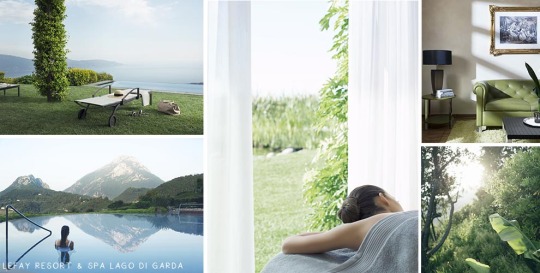
Taking inspiration from the tiered lemon houses of Lake Garda, Lefay Resort & SPA Lago di Garda has been awarded our Hotel of the Year award for its strong eco-friendly philosophy and outstanding wellness area combining classical Chinese medicine with Western scientific research. Offering highly customized treatments designed to cure stress and insomnia, Lefay SPA extends over 3,800 square metres boasting six saunas of varying temperatures, an ice pool and a large salt lake. The hotel also produces electricity, heating and cooling through clean, renewable sources such as biomass, cogeneration and solar panels, generating a reduction in CO2 emissions of 1.130t per year.
INVITED Hotel of the Year – The Tokyo Station Hotel, Japan

Located inside The Tokyo Station Marunouchi Building, INVITED guests praised The Tokyo Station Hotel for preserving its deep-rooted heritage, from QR codes attached to framed old photographs and notepads made of Japanese manuscript paper to staff wearing pillbox hats and train timetables hanging in the corridors. The property’s sumptuous Japanese and European style buffet breakfast should be high on any traveller’s bucket list, displaying around 110 items including rolled omelettes, sashimi, tempura and mini wagyu burgers.
Highly Commended – Dormy House Hotel (UK); Velassaru Maldives (Maldives); Hotel Relais Christine (France)
City Centre Hotel of the Year – The Norman Tel Aviv, Israel

Located in a UNESCO-designated site with the world’s highest concentration of Bauhaus-style buildings, it was only a matter of time until The Norman Tel Aviv was named our City Centre Hotel of the Year. From a rooftop infinity pool offering unbeatable views of Tel Aviv, a restaurant serving the best Japanese food in the country to resident DJs and a private art collection including its own in- house curator, it is no surprise that The Norman is regarded as one of Israel’s best boutique hotels. The expert concierge can arrange bespoke experiences for guests including the chance for them to craft their own signature scents with a perfumer or giving them access to usually off-limits artists’ studios.
Highly Commended – Hotel Lungarno (Italy); Refinery Hotel New York (USA); DUKES London (UK)
Country House Hotel of the Year – Château La Chenèviere, France

Set along Normandy’s lush, north-west coast, Château la Chenevière ticks all the boxes of a grand yet welcoming country house hotel including marble fireplaces and velvet-backed beds as well as beautiful rose gardens with beehives, an outdoor pool and a tennis court – not to mention the fact that it’s dog-friendly. Both dining rooms serve delicious dishes prepared from fresh ingredients supplied by the on-site vegetable garden, where sustainable and natural permaculture techniques are in practice. The hotel’s speakeasy-style Zanzibar bar is not to be missed featuring a collection of the owner’s travel souvenirs and Calvados-themed cocktails such as the signature ‘Chenevière cocktail’ – a combination of pommeau (apple port), peach cream and champagne.
Highly Commended – Schlosshotel Kronberg (Germany); Stein Eriksen Residences (USA); Hotel Rangá (Iceland)
Resort Hotel of the Year – Hotel Villa Franca, Italy
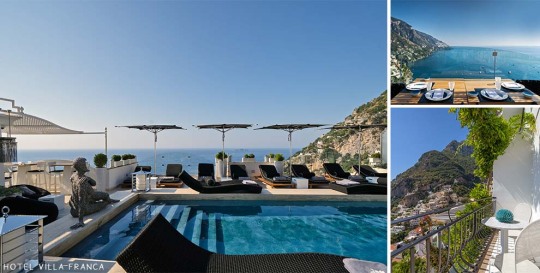
Perched high on the hill overlooking the town of Positano, Hotel Villa Franca has been awarded Resort Hotel of the Year for its top-notch facilities and wide range of experiences including an L-shaped swimming pool with stellar views of the Amalfi Coast, lemon-infused spa treatments to detoxify the body and a fine dining restaurant rooted in Campanian culinary traditions. The resort can arrange a special Amalfi lemon tour for guests, where they get the chance to taste the citrus fruits hanging from pergolas and sample them in homemade cakes, drinks and of course, limoncello.
Highly Commended – Nobu Hotel Ibiza Bay (Spain); Canaves Oia Suites (Greece); Keemala (Thailand)
Mystery Inspectors’ Excellence Award – Hemingways Nairobi, Kenya

Set between Nairobi National Park and the foot of the Ngong Hills, Hemingways Nairobi offers personalised service with the kindness inherent to East African culture. A bespoke butler service ensures guests are catered to their every whim, from tailor-made afternoon tea and arranging outings to The Giraffe Centre or the Karen Blixen Museum, to adjusting their customised pillows, setting out their nightcap and packing their suitcase for departure.
Highly Commended – Grand Hôtel du Palais Royal (France); Pimalai Resort & Spa (Thailand); Rockliffe Hall (UK)
Sustainable Innovator of the Year – Arima Hotel, Spain

Hidden among the trees in the Miramón Forest of San Sebastián, Arima Hotel’s building structure is named as a prototype of zero-energy buildings, marked by the European Union as a mandatory standard to mitigate the effects of climate change. Its savings in CO2 emissions compared with a standard construction are similar to the carbon that 15,000 trees would absorb annually. From clean energy systems, sulphate-free toiletries to a menu inspired by locally-grown ingredients at veggie-focused fine dining restaurant Misura, the hotel has set a new benchmark in terms of environmental and social responsibility, as evinced by its rigorously audited Passivhaus qualification. Overall, 77 per cent of Arima Hotel’s energy needs are fulfilled from aerothermal and geothermal power.
Highly Commended – Susafa (Italy); Petit St Vincent (St Vincent & The Grenadines); Domaine de Manville (France)
Stay Small, Stay Considerate Award – Lefay Resorts, Italy
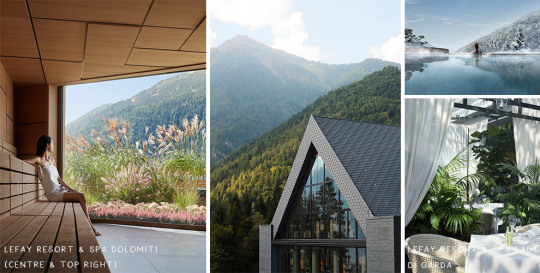
Created around the philosophy that personal wellness should never overlook environmental wellness, Lefay Resorts is fully committed to operating in the most responsible way possible, whilst creating a haven of luxury and wellbeing. As the first Italian hospitality company to sign an agreement with the Italian Ministry of the Environment aimed at neutralising C02 emissions, both its hotels in Lake Garda and The Dolomites (which opened in August 2019) are 100% carbon neutral. The company offsets its direct CO2 emissions and those of travelling guests through the purchase of CERs credits in accordance with the Kyoto protocol. Established from the outset with landscape protection and energy efficiency at the fore, great efforts are also taken to ensure the guest experience is grounded in sustainably practices. All the products used in its spa are vegan, free from parabens, SLES (a detergent that causes skin irritation), colourings and preservatives. Lefay also handpicks its food suppliers ensuring they adhere to strict environmental standards with 66% of ingredients sourced directly from the local provinces. The company’s results and objectives are summarised in an annual Sustainability Report that is published on its website.
Highly Commended – Tabacón Thermal Resort & Spa (Costa Rica); AKARYN Hotel Group (Thailand); Gaya Island Resort (Malaysia)
Most Inspirational Interior Design – Castello di Reschio, Italy
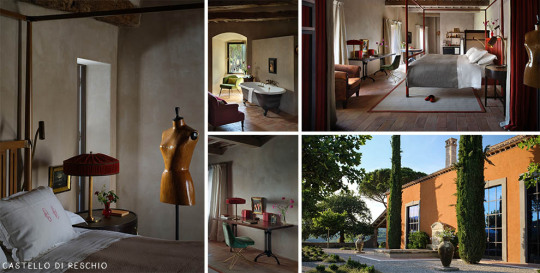
Nestled amongst rolling hills on Italy’s Umbria-Tuscany border, Castello di Reschio is a thousand-year old castle which has been meticulously restored and stylishly reimagined by architect Count Benedikt Bolza and his wife, Nencia Corsini. The hotel’s rooms and suites have been imbued with personality and panache, thanks to an organic approach to contemporary design coupled with subtle references to the fascinating characters who once lived here. Count Benedikt designed much of the furniture and lighting himself and sourced rare pieces from Italy’s below-the-radar antiques markets and art fairs.
Highly Commended – Le Coucou Méribel (France); Gangtey Lodge (Bhutan); Ksar Char-Bagh (Morocco)
Most Intimate Bedroom – Cap Rocat, Mallorca
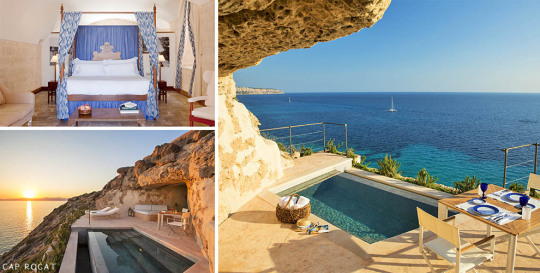
Housed within a striking 19th-century military fortress, Cap Rocat’s three Sentinel suites are wonderfully secluded, carved out of the rocks that the fortress was built into, with private infinity pools featuring unobstructed views of Palma Bay. The three intimate rooms, which once served as watchtower spots, are each decorated with sumptuous king-sized beds, refined rugs, soft Mediterranean fabrics and a private terrace. Maps are given to guests upon check in so they can find their way along the hotel’s secret corridors and pathways, some still partly covered with plants.
Highly Commended – Thorngrove Manor (Australia); Carmo’s Boutique Hotel (Portugal); Le Grand Bellevue (Switzerland)
Most Mindful Wellness Retreat – Castle Hot Springs, Arizona
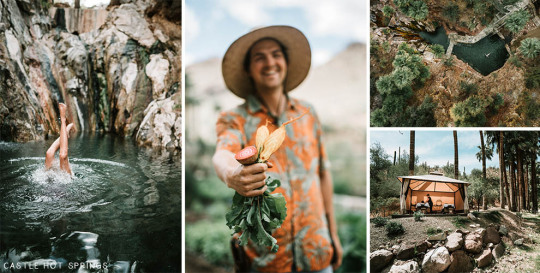
Disconnect from the busy world and reconnect with yourself and nature at Castle Hot Springs with the rustic Bradshaw Mountains as the backdrop. The resort’s remote location, tucked in a rugged canyon surrounded by Saguaro Cacti, makes it an oasis in every sense of the word. The star of the show are the three hot springs that well up from deep within the desert surface and offer pristine 115-degree waters filled with revitalising minerals. The waters are also piped through for guests to enjoy in their rooms and to feed the three-acre sustainable farm. Guests can further take in the landscape doing immersive activities like hot springs Paddleboard Yoga and Via Ferrata – a state of the art course and one of only a handful in North America. Castle Hot Springs spa services are provided in custom cabanas set along the spring water creek under towering palm trees, and offer fully customised treatments using hot stones from the springs.
Highly Commended – Quinta da Comporta (Portugal); Lefay Resort & SPA Dolomiti (Italy); Spa Village Tembok Bali (Indonesia)
Most Intense Bespoke Experience – The George, New Zealand
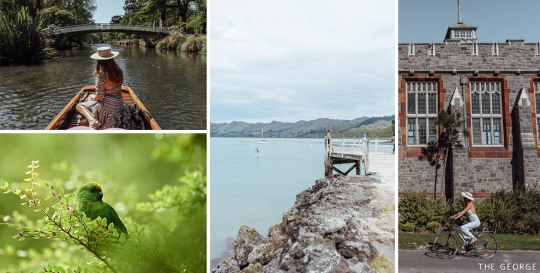
Drawing upon the traditional Maori cultural values of care and guardianship, The George offers an exclusive half-day Flight Path Conservation Experience accompanied by an Endangered Species Ranger. Guests are taken on a half day trip to Canterbury’s forest valleys to support the conservation efforts for the critically-endangered orange-fronted Kakariki, a native parrot whose numbers are estimated at fewer than 300. Once a year, by special arrangement, guests can even release one of these treasured birds into the forest. A portion of every flight from the Conservation Experience is donated to the recovery programme.
Highly Commended – Nobu Hotel Ibiza Bay (Spain); Milaidhoo Maldives (Maldives); Pangkor Laut Resort (Malaysia)
Best Gourmet Experience – The Seminyak Beach Resort & Spa, Bali
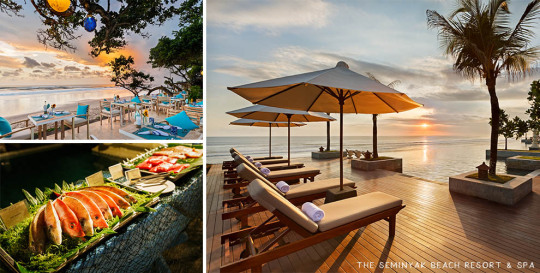
Located in the heart of Seminyak in Bali, The Seminyak Beach Resort & Spa has launched Bali’s first ever Dine in the Dark event, inviting guests to discover food in a whole new way – without seeing it – in collaboration with Yayasan Dria Raba, a donation-only orphanage for visually-impaired children. Held in the resort’s darkened Klass & Brass private dining room, the six-course sensory dinner experience has been thoughtfully curated to focus on texture, aroma and flavour, while being served and guided by children from the orphanage. The aim is to help provide the children with employment opportunities and basic hospitality training while raising awareness for the vision-impaired people of Indonesia. The experience is available any day of the week with a minimum one day reservation and at least eight participants.
Highly Commended – The Atlantic Hotel (Channel Islands); Castle Hot Springs (USA); Halcyon House (Australia)
Local Food Champion – Chef Marc Collins at Wentworth Mansion, Charleston
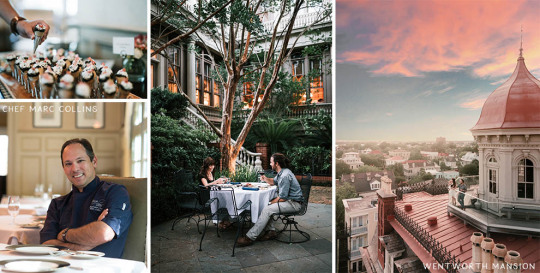
Located in central Charleston, Wentworth Mansion’s restaurant Circa 1886, is regarded as one of the best in the region. Beyond working with local farmers and fishermen to curate the best local Southern dishes, their executive chef Marc Collins also holds the title of South Carolina Chef Ambassador. Chef Collins co-founded the Charleston Wine + Food Festival in 2006 with the objective to spotlight Charleston and the Lowcountry’s diverse culinary and hospitality community. In 2019, he launched a unique menu concept that takes guests from South Carolina’s humble beginnings to Charleston’s Southern-modern foodie scene. Culinary highlights include the Broken Arrow Axis Venison with sunchoke hash and sunflower seed butter and Piedmontese Oxtail with conch fritter and mustard greens.
Highly Commended – Chef Salvatore Minneci, Susafa (Italy); Chef Carvison Pratt, Sailrock Resort (Turks & Caicos); Chef Jim Hopkins, Stein Eriksen Residences (USA)
Hotel Hero Award – Michael Ferreira, Guest Experience Manager of Le Barthélemy Hotel & Spa, St. Barths

Located in chic St. Barths, Le Barthélemy Hotel & Spa’s personalised service is exemplified through Guest Experience Manager Michael Ferreira, who goes above and beyond to put a smile on every guest’s face. Michael’s proactive attitude has been demonstrated though arranging a leg massage for a guest who returned from the day’s exploration with a leg pain, and anticipating the needs of a cancer patient who was checking in with a unique welcome amenity of detox juices, sun cream and hat. Always looking out for his guests, Michael has accompanied a Portuguese guest to the hospital to help translate and make sure that the guest was well-taken care of. Michael showed true dedication when two guests fell in love at Le Barthélemy and spontaneously decided to get married – he organised the entire wedding event, from master of ceremony to musicians and floral arch, within 24 hours.
Highly Commended – Laksiri Perera, The Fortress Resort & Spa (Sri Lanka); Harold Shepherd, The Sandpiper (Barbados)
Travel Agents’ Hotel of the Year – Hôtel Relais Christine, France

Built atop a 13th-century Augustinian monastery in Paris’ Saint-Germain-des-Prés district, Hôtel Relais Christine was commended by travel agents for its refined calm, remarkable home-from-home ease and vintage glamour. From a secret garden with beehives producing honey for the hotel’s breakfast table to the basement Spa Guerlain with its medieval stone vaults and impressive display of Guerlain perfume bottles, everything about this hotel exudes intimacy and charm.
Highly Commended – Viceroy Bali (Indonesia); Hotel Vilòn (Italy); Casa Angelina (Italy)
Most ‘Liked’ Hotel of the Year – Halcyon House, Australia

Found on Instagram as @_halcyonhouse, it is without a doubt that Halcyon House‘s colourful and eclectic interiors and idyllic beachside setting make it so Instagrammable. The hotel is often lauded for its ‘Instagram-worthy interiors’ including its unique mix of ocean blue décor juxtaposed with bold clashing prints, vintage cameos and beachside paraphernalia. Everything about the hotel is photogenic from the blue and white wicker chairs in Halcyon’s Paper Daisy restaurant to the blue and white candy-striped loungers next to the pool area.
Highly Commended – Canaves Oia (Greece); Castello di Reschio (Italy); Cap Rocat (Spain)
Digital Excellence Award – Triumph Hotels, New York
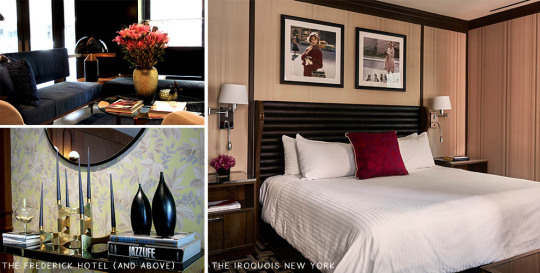
Triumph Hotels underwent a revamp of all their digital platforms in 2019, including those of SLH member hotels The Frederick Hotel and The Iroquois New York. Reflecting the aesthetic and contemporary edge of the hotels, the newly designed websites employ an experiential approach that brings to life the destination and energy of New York City.
The post The Trailblazers of Boutique: SLH Award Winners 2020 appeared first on Small Luxury Hotels.
from Small Luxury Hotels https://ift.tt/33d1PBC Publish First on
0 notes
Link
Best Buddies International, a groundbreaking nonprofit that creates opportunities for one-to-one friendships, integrated employment and leadership development for people with intellectual and developmental disabilities (IDD), is pleased to announce its 21st Annual Best Buddies Miami Gala at Ice Palace Studios in Wynwood on Friday, November 17. The 21st Annual Best Buddies Miami Gala is a spectacular event with hundreds of prominent locals and international guests gathering to celebrate the Best Buddies mission. This year’s Best Buddies Miami Gala will celebrate the organization’s expansion into India. Guests will enjoy a gourmet dinner, partake in a top-notch auction and witness dazzling entertainment. During the Gala, Ralph Winter will be honored with the Spirit of Leadership award for his $1 million gift to Best Buddies that will be used to promote and expand the organization’s mission of friendship, jobs, and leadership development for individuals with IDD around the world. “We are incredibly excited to celebrate Best Buddies’ expansion into India, where we hope to exemplify the true spirit of friendship and inclusion for individuals with intellectual and developmental disabilities,” says Anthony K. Shriver, Founder, Chairman & CEO of Best Buddies International. “Moreover, I am proud to celebrate the Best Buddies mission with some of our most dedicated supporters, participants, and volunteers. The Miami Gala is a fantastic way to thank and celebrate the achievements of our participants and supporters, as well as remind everyone of our mission and importance of the work that we do on behalf of individuals with special abilities.” Each year, the Gala brings together Miami’s most notable residents and celebrities from around the globe. Among those expected to attend this year’s event includes: Best Buddies International’s Founder, Chairman & CEO Anthony K. Shriver and his wife, Alina Shriver; Actors Nolan Gould, Jason Lewis and Kevin McHale; Actress and Model Charlotte McKinney; Four-time Tour de France Winner Chris Froome; Miss Teen USA 2017 Sophia Dominguez-Heithoff; and International Pop-Artist Romero Britto. The evening will conclude with a special musical performance by four-time Grammy nominated, multi-platinum Australian rapper Iggy Azalea! There will also be a number of one-of-a-kind items up for auction, including a limited edition Hublot Best Buddies Cycling Timepiece, a custom portrait by Romero Britto, and a once-in-a-life-time opportunity to be a part of Dolce & Gabbana’s Ready to Wear show in Milan, Italy, which includes a special meet and greet with Mr. Domenico Dolce and Mr. Stefano Gabbana. The day’s festivities will kick-off bright and early with the Best Buddies Challenge: Miami, a 100K six-star cycling event, limited to just 50 cyclists, that starts and finishes at Marlins Park. The Challenge will be led by Tour de France winner Chris Froome, and pro cyclists George Hincapie and Christian Vande Velde. As a result of phenomenal support from generous sponsors and donors, Best Buddies is able to extend its reach globally, and will continue to develop its presence through its eight formal programs — Best Buddies Ambassadors, Citizens, Colleges, e-Buddies, High Schools, Jobs, Middle Schools and Promoters— across the United States and in nearly 50 countries. Proceeds from the Gala will allow Best Buddies to continue making a meaningful impact in the lives of individuals with special abilities on a global scale.
#Kevin McHale#Nolan Gould#Jason Lewis#Iggy Azalea#Charlotte McKinney#21st Annual Best Buddies Miami Gala
1 note
·
View note
Text
The Moment Paris-Nice Was Won

In 1972 Eddy Merckx was so confident of winning Paris-Nice that before the start of the final stage he posed for photos with a speedboat, a prize that year. Only Raymond Poulidor rocketed up the Col d’Eze to win the stage, take the race overall and collect the prize. Primož Roglič can show a cannibal-like trait at times but must also know a thing or two about not counting chickens until they hatch, or as they say in Slovenian, “not praising the day until the evening”. But on the morning of the final stage it did look like Roglič had Paris-Nice sewn up and he even had a good chance of winning the final stage too…
Many star riders had opted for Tirreno-Adriatico, but if two simultaneous World Tour races might sound incongruous to outsiders or management consultants, the format works well with a large share of the peloton able to bank a week-long stage race in mid-March and views able getting double the action. Perhaps more than Wout van Aert or Julian Alaphilippe, the one thing Paris-Nice really missed this year was the wind. Ride from Paris to Nice and long days across the plains are inevitable, and if the weather is benign, so is the racing.
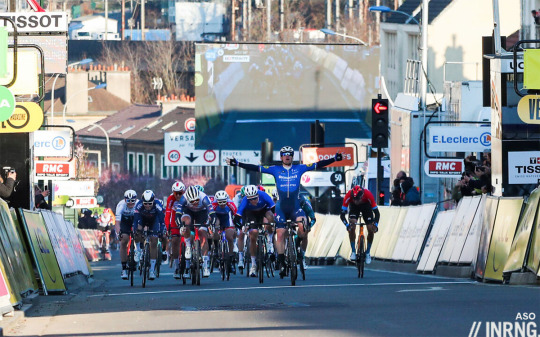
We got some fine bunch sprints, but this is the sporting version of nouvelle cuisine when we’d hoped for a feast, a daily dish to be consumed in seconds rather than hours. Sam Bennett won the opening stage in Saint Cyr and would take second while Cees Bol seized the moment to take a chaotic finish, too.
Without echelons on the first two days, the time trial in Gien was the first obvious rendez-vous for the GC contenders and Roglič was the best, just behind Stefan Bissegger and Rémi Cavagna, with Brandon McNulty close, then Max Schachmann and Sacha Vlasov close by. The likes of Tao Geoghegan Hart, Jai Hindley, David Gaudu and Guillaume Martin were among those on the receiving end in a 14km time trial and they’ll face four times this distance if they ride the Tour de France.
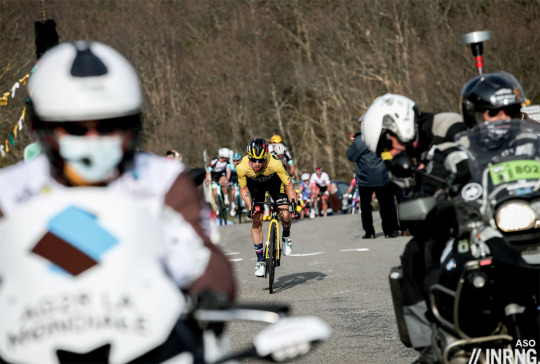
The wine stage past Macon and into the Beaujolais was a lively one with a difficult finishing circuit. These are not legendary roads but they do offer great riding for visitors and make just as good terrain for racing as they do red wine. All talk of wine tasting was spat out with Roglič’s late surge to win solo as he crushed his rivals like they were grapes in a vat. He took 12 seconds by the line and another 13 in time bonuses with Schachmann again close by, and this was the German once again the second best. Schachmann finished 19th on the stage to Biot won by Roglič, but all were on the same time so this momentary gap didn’t cost anything.
Schachmann was back on Roglič’s wheel for the big mountain top finish to La Colmiane. Gino Mäder was the lone breakaway survivor and with a chance of the stage win, but after everyone else was dropped Roglič launched one last time to shake off Schachi and got clear, rounded Mäder and took the stage win, his third so far. Some would have preferred if he could have let Mäder win, but this was no place for gifts with Roglič being hounded by Schachmann, who’d been right on his wheel and still seconds separating the main riders on GC with a tricky stage behind Nice still to come, rather. We don’t need hindsight to see Roglič couldn’t afford to play Santa either. Name a rider who has lost a stage race because they didn’t distance their rivals enough: Roglič. Name a rider who has seen stage races slip from him on the last day: Roglič. He’d be a tragic figure if it wasn’t for all the races he wins.
The final stage of Paris-Nice is never a victory parade. Ever since the Col d’Eze time trial was abolished it’s often the most difficult and spectacular day of the week. Still, the briefing on the Jumbo team bus wouldn’t have lasted long, a stage on the same roads as last summer’s Tour de France and within easy riding of several of the squad’s Monaco apartments presented few surprises and they needed to keep a lid on the race so that Schachmann and Astana didn’t take time; maybe letting a breakaway go to mop up the time bonuses would help. “Just keeping Primož safe to bring it home“.

Which brings us to the moment the race was lost. Or rather the moments, because like many disasters, it’s not one mishap but a chain of events. The first crash on the descent from Levens to Roquette – the same used in the Tour de France’s opening stage last year, the ice-rink stage – where he dislocated his shoulder and had his shorts shredded. Many would demand days off work following an accident like this, yet Roglič was back on the bike but, however quickly we see a rider remount, these incidents are never cost-free. Muscles ache, skin burns, adrenalin has burned up energy reserves, swelling starts and more. Then Roglič crashed again on the same descent the next time and jammed his chain. He got a replacement bike but had to chase and there was a barrage, where the convoy was being held back, leaving Roglič and his Jumbo-Visma teammates to close the gap. They’re strong, but lacked a big rouleur and the likes of Oomen, Kruijswijk and Bennett were spent quickly in the chase up the Vésubie valley, leaving Roglič alone to close the final gap of less than ten seconds. This was the point of maximum danger, where the final metres are often the hardest part of the gap to close, and meanwhile, Astana and Bora-Hansgrohe had riders on the front, so it was a lone rider in yellow versus a team trial.
Roglič never gave up though, climbing as fast as he could and prompting many double takes from dropped riders coasting up the last climb and upon reaching the finish, congratulated Schachmann on his win with a fist-bump when by all accounts he might have felt like something less gracious and would be entitled to vanish inside the team bus right away (he didn’t show up for the podium ceremony to collect the points jersey). Schachmann himself said he didn’t want to win this way but he did, and not just because Roglič crashed, but because someone else had to win and all throughout he was the second best rider. It’s a small consolation for last year’s winner on his way back after that accident in Bergamo that broke his collarbone.

The Verdict Not a vintage edition because the wind didn’t enliven the opening stages and once the race reached hillier terrain, the GC battle wasn’t much of a contest either. But like a restaurant that served up a surprise dessert, the memory might be of the final dish in the hills behind Nice. Primož Roglič looked to have the race sewn up with two stage wins and being the best-placed GC rider from the time trial, but all this just left him seconds ahead of his rivals and one crash was enough to topple him from the podium. He wasn’t alone: Richie Porte, Tao Geoghegan Hart and Brandon McNulty would also crash out of the race, and the absence of Ineos’s leaders allowed Jumbo-Visma to keep a grip on the race all week, but the final stage twist just adds to the lore of Paris-Nice.
Paris-Nice is often a small dress rehearsal for the Tour. Younger riders get a go and the youth competition showed strong rides by Vlasov, Lucas Hamilton, Jorgensen, McNulty and Paret-Peintre. It’s a tune up for next weekend’s Milan-Sanremo, too. But perhaps the long term effect will be on Jumbo-Visma; the team will give leadership to some of their other riders in upcoming stage races but last week’s racing suggests they’ll play it even safer in July.
The Moment Paris-Nice Was Won published first on https://motocrossnationweb.weebly.com/
0 notes
Text
Different types of Bicycles Accessories Available on the Economy

Bicycles accessories will be the items that are unique to bikes as well as their customers. There's a world of accessories for bicycles, and it's getting larger by the day. It's also a wonderful thing to do as you will have the ability to enlarge your cycling knowledge. It's always sensible to keep abreast of the latest accessories that are accessible, so you may use them to boost your cycling experience so that you don't have to replace them each year when they start to show signs of wear and tear. Cycling is a superb sport or hobby which could provide a lot of enjoyment. There are many ways to enjoy it, and one of those ways is to cycle in style with accessories that are designed especially for this action. Among the very best accessories to buy for your bicycles is a rack for storing your bicycles in. There are many distinct types of racks which can be found which range from back racks to a side rack. These are extremely useful when you travel round the north America and east Asia in your bicycles. 1 type of stand that is rather well known at the north America region is the roof rack. This rack can be used to store bikes on top of your car or truck, or it can be fitted onto the back of your car. Another popular accessory for bicycles in the north America and east Asia region is a rack for touring bikes. This type of rack is used for transporting flying bikes around the areas. You can find these racks available in most of the bicycle shops, and they're frequently made from strong but lightweight materials. A touring bicycle rack is beneficial for traveling through areas where cycling is a favorite activity. One of the greatest cycling events occurring in north America in the moment is the Tour de France bicycle accessories marketplace. This is a multi-stage cycling event that occurs through the continent. It comprises over hundreds of kilometers of cycling tracks and has a stage race, which is considered to be the most challenging one. The overall winner of this event is the person who completes the most kilometers in the particular time period. It is held every year and is regarded as among the greatest cycling events in the world. Bicycle fans from the north America area are continuously looking at new ways to better their bikes so they can make them more effective and lose excess weight. 1 way to do this is by obtaining rim locks for bicycles. These are devices which can prevent rim locks from being engaged when the rear wheel of the bicycle is spinning. Rim locks are placed on the rear wheels of bicycles in order when the tires are turning the locks can't be released. They stop the tires from moving when the bike is in motion and block the bike's wheel from coming off when it comes to flat out. Click here bicycleally.com to obtain more information about bicycles.
0 notes
Text
Commentating the Tour de France is an Ironman sport
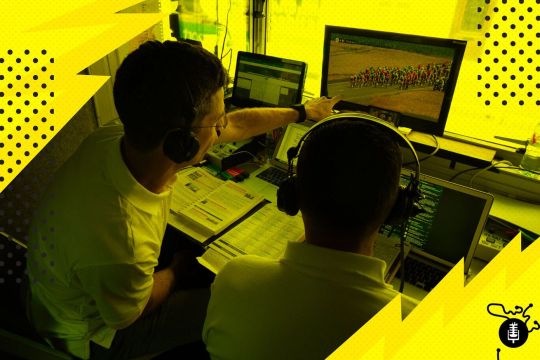
Inside one day of the hardest job in sports commentary.
Matthew Keenan is the fastidious one, while Robbie McEwen likes to play a little looser.
Keenan is still studying a notebook of the day’s historical landmark notes while McEwen chats with me. Keenan talks back to the production room through his mic set. They’d been having some technical difficulties.
Keenan says, “I can assure you, Robbie’s not having any problem with the fiber.”
McEwen replies, cheerfully, “Good fiber is the start of a good day.”
Keenan gets a note from the booth: “Are we on at 12, not 12:05? Huh, lucky I went to the bathroom already.”
It’s 11:57, and McEwen is explaining to me why he and Keenan work so well together.
“There was a really easy, natural flow,” he says. “I think the moment when we really clicked and everyone truly knew was our commentary of the 2016 Paris-Roubaix when Matthew Heyman won. Of course we were excited because it was a fantastic race, it was an incredible performance. But also being an Australian, also being one of his last chances of winning at Roubaix, and then winning it. I think we both had the same level of excitement and emotion.
“I think that was the moment a lot of people went, ‘This is the pair.’”
With roughly 10 seconds to go until the broadcast starts, McEwen signals that he has to focus and settles his headphones into place. There’s an issue with the monitor so they can’t see a countdown. Keenan has to begin the broadcast off the production truck’s cue while standing up and looking through a window into the neighboring broadcast booth for visuals.
”I have no pictures, I’m watching the Norwegian broadcast,” he says. Then he flips the switch that unmutes his mic for the audience and, after a beat, begins:
“After two days of racing on Belgium roads, it says farewell to the Tour de France, and on Stage 3 it heads home to France itself for the stage finish in the champagne capital of Epernay. Matthew Keenan with you ...”
For the first 40 minutes, Keenan and McEwen take turns talking back to the production truck while the other calls the race. The video feed finally comes through the monitor around 12:05, but Keenan points out that “audio is still going in and out as Robbie speaks.” At 12:09, Keenan narrates for the audience, “... rolling into the 4-kilometer start before the racing truly gets underway,” as McEwen tells the booth, “And me, I can’t hear Matt at all.” Keenan then says, “A lot of freezing as well.”
The audio mostly settles down after a half-hour of alternating from crackling, to too soft, to ear-splittingly loud. The two seem to get more comfortable after that. McEwen elongates his cadence a bit when a bearded man with tasteful plumber’s crack enters their maybe-five-foot-wide booth inside a two-story tractor trailer and has to move Keenan around to replace his fritzing personal monitor.

Ryan Siu
Robbie McEwen is a 12-time Tour de France stage winner.
After the stage, both would note that it was a particularly rough technical start, even for a sporting event that’s known for its logistical headaches.
“There was not only no picture, the sound wasn’t working, nothing worked,” McEwen says.
Keenan nods, “That was messy.”
“And when you can’t hear yourself you start to doubt that you’re even on.”
“And it throws your confidence in the way you deliver. That’s what I’ve found.”
“First two stages were no dramas,” Keenan adds.
“Because we were in Belgium.”
Yet nobody watching on television knew the extent of the problems. Only McEwen’s audio issues leaked onto the early part of the broadcast, which he found out through Twitter. Otherwise, in a testament to their calm, practice, and professionalism, it seemed to anyone listening like a routine start to a Tour broadcast.
Cycling has a keen way of dulling the stress response in both participants and anyone who tries to cover it. It’s a perfect sport to laze about to, and Keenan and McEwen have perfected a soft, jovial, cadenced Aussie banter that works on any topic.
Which is good, because early in many stages there isn’t much to talk about.
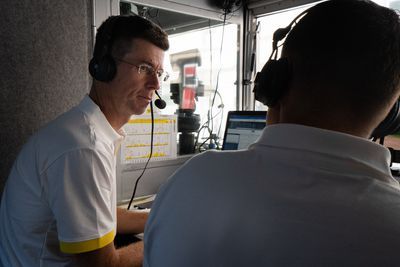
Ryan Siu
Matthew Keenan began commentating on cycling at Australian velodromes in 2003 as way to stay connected to the sport.
”I don’t think Tim Wellens could find a bigger banana to take with him on the stage today,” McEwen chimes a little after the half-hour mark. “One thing’s for certain: He’ll be getting his carbohydrates and potassium, not cramping. He’s got enough banana there to feed a family.”
”Oh, it is the original sports food,” Keenan notes. “Who needs all the packaging? And mother nature has done it best.”
Commentating the Tour de France mandates having a sense of humor, and it’s the same joviality that helps them roll with the punches. Mic problems are far from their biggest worries. The job requires long hours. Most stages are six or seven hours long, spread across 21 stages in 23 days. Keenan and McEwen were hired by the Tour’s organizers Amaury Sport Organisation (ASO, for short) to work the official English language feed, which supplies NBC Sports Gold and SBS in Australia, among others.
They work without commercial breaks, which means no prescribed bathroom breaks, either. Keenan calls that fact by far the most physically demanding part of the job.
“A man’s not a camel,” he says. “Luckily, they have a port-a-loo very close to the commentary tribune, and you know the moments where you’re not going to be able to go for a nature break. The last 30 kilometers or the last 50 kilometers, it’s out of the question. But if you’re going through a period where it’s a little bit dull, you take an opportunity and you duck out.”
If it’s a particularly important stage, Keenan will make sure he’s as dehydrated as possible before he goes into the booth, and that way he can take sips of water to keep his mouth wet without having to leave his post. As of yet, he has never missed a significant move or crash while he was out using a facility, though he knocks on wood in case he’s jinxed himself.
Wait until the pace is slow, gather the necessary supplies, find a (relatively) quiet spot & get it all done as quick you can. #whenyougottagoyougottago #everybodypoossometime
— Robbie McEwen AM (@mcewenrobbie) July 13, 2019
Keenan compares commentating cycling to an Ironman sport. Anyone would be hard-pressed to think of a harder commentary gig, a fact that Keenan takes great pride in.
“Part of the charm of the Tour de France is the physical torture of it. Just how difficult it is, how long and unrelenting it is,” Keenan says. “And I like the idea of being able to broadcast that and be a small part of it, and bring it to people from a much more comfortable seat than it is on the top of a bike.”
Listening to a broadcast gives a bad impression of where they’re sitting. By the sound of Keenan and McEwen’s dulcet jocularity, you might think they were on a veranda shooting bull over cocktails. In reality, they’re packed in a beast of a trailer that’s parked roughly 1.5 kilometers from the finish line. They’re nearly shoulder-to-shoulder in a cubicle that sits in a long row of cubicles where other broadcast teams are yammering away in their own respective tongues. The walls are covered in rough gray fabric. Behind them is a corridor that’s maybe two feet wide, just enough that anyone going through has to be careful not to bump their chairs. Which is often, because the door to the trailer opens right on them.
Tour stages usually start some time between 11 a.m. and 1 p.m. local, so lunch has to happen on the fly. Shortly into the broadcast, a production assistant sneaks in and slides meals packed in covered cardboard trays under their chairs. They look good — a piece of beef, a carrot/cauliflower/broccoli mash, tomato and mozzarella salad, couscous, a piece of Brie, bread, an apricot, and zucchini.
At 12:49, a roughly minute-and-a-half ASO-produced video segment on French rider Julian Alaphilippe airs, giving the guys a brief break to scarf down their nicely-packaged meals. Keenan eats as much as he can before putting his tray back under his seat. McEwen keeps his on his lap as the segment ends. The two begin talking again, and McEwen slices into the beef as he notes that German rider Max Schachman is “having a very good season.”

Ryan Siu
The production village before Stage 3 of the 2019 Tour de France, finishing in Epernay.
Keenan is married to the job, almost literally.
“I spend about half the year in a hotel room,” he says. “My wife is hilarious; she says, ‘We’ve been married for 12 years, together for six.’”
Cycling is an almost year-round sport, and Keenan covers practically every level of it. He covers ASO’s biggest races from the ground — Paris-Nice, Paris-Roubaix, and the Vuelta a España. The rest he covers remote at the Sydney office for SBS with McEwen, including the spring classics — like, Tour de Flanders, Liège-Bastogne-Liège, and Amstel Gold — the Critérium du Dauphiné, and the World Championships.
He started calling local velodrome races in Australia in 2003 as a way to stay in the sport. He claims his cycling career wasn’t much — “I was good at raising other people’s confidence” — but he enjoyed calling the races enough to try to make it his day job. He worked with legendary commentator Phil Liggett on Australian races, and Liggett eventually introduced him to ASO. In 2007, Keenan took over commentating the first half of Tour stages by himself, before handing off to Liggett and his partner, the late Paul Sherwen.
The experience was a good test of mettle. The first half of Grand Tour stages are notoriously dull, and Keenan was all alone in the booth. The Tour’s commentary production feels surprisingly barebones, and was even more so then, Keenan says.
“I just had a 30-second countdown, and the pictures come up, and you start talking. And then I would get a 10-second warning when I was to hand it over to Phil and Paul,” Keenan says. “So I felt quite lonely. That was one of the bigger challenges, you’re out there on your own, and wondering is anybody listening.
”But as soon as you made a mistake, that’s when you found out.”
Fans would sometimes tell him to be more “conversational.”
“Well that’s difficult when you’re on your own,” Keenan laughs. “And I couldn’t understand that feedback.”
“Part of the charm of the Tour de France is the physical torture of it ... and I like the idea of being able to broadcast that.” - Matthew Keenan
But Keenan had no lack of enthusiasm, and was willing to do the homework necessary to buff out any rough edges. Liggett and Sherwen were instrumental in both his and McEwen’s careers, which Keenan felt was remarkable given how competitive the industry can be, and how few opportunities there are to commentate the highest level of the sport.
He took pointers from them. For the Tour, Liggett and Sherwen used a database that they updated together throughout the season with notes about every rider. Now, Keenan keeps his own database that he deliberately refuses to fill with race results. He fills it with color, instead — riders’ personal and family histories, injuries, anecdotes. Keenan is obsessed with a well-composed broadcast.
”I used to put a note on the TV monitor — and it’s just ingrained now — but the first dot was ‘add value to the pictures,’” he says. “So don’t tell people what they’re seeing, but why they’re seeing it.
“Dot point No. 2 was ‘let it breathe.’ Sometimes it’s better just to be quiet and hear the crowd cheering from the side of the road. And the third dot point was ‘light and shape.’ Look for some variety. You can’t be serious all the time, you can’t have the same tone of voice all the time.”
Liggett and Sherwen were the two best mentors he could hope for. The two worked together for 33 years as the voices of the Tour de France. To English-speaking fans, their voices sounded like cycling, and it’s hard not to catch the same iconic cadences while listening to Keenan and McEwen. Like when the riders cross over from Belgium in Stage 3 and Keenan announces, with measured whimsy:
“And Robbie …”
Pause.
“... The Tour de France …”
Pause again.
“... is in France.”
Sherwen passed away in his sleep last December, and his absence is acutely felt in the technical village, where broadcast crews from all over the world set up each day to cover the Tour. Inside the SBS production truck before Stage 3, producers reminisce about what he meant to them and the Tour. Jan — who works for Free Lens, a French independent audiovisual production company that SBS partners with for every Tour de France — says that Sherwen took care to get to know them, that “he knew that it was a production. He was with the crew.”
Catherine Whelan, SBS’ head of sports programming, says one of Sherwen’s best qualities was that he was interested in everyone, and that when he passed, stories about his generosity came from an overwhelming number of people, “not knowing that so many other people had these beautiful connections with him.”
“Our team, we still think, ‘he’s going to turn up.’ But that’s not the case,” Whelan says. “Everyone was affected very deeply. And the thing about Paul was everyone felt special to him, because he made everyone feel special.”

Ryan Siu
Outside the SBS production trailer before Stage 3 of the 2019 Tour de France.
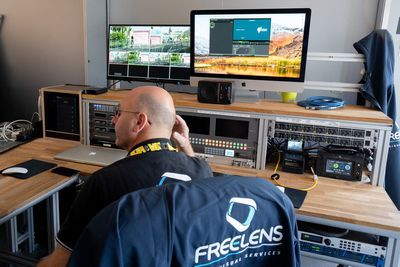
Ryan Siu
Inside the SBS production trailer before Stage 3 of the 2019 Tour de France.
Keenan calls Sherwen the most influential mentor he’s had in commentating.
“One of the great things that I learned from Paul is, everybody makes mistakes,” he says. “You will deal with critics. But just remember that you’re the one that’s in the chair. Back yourself, and don’t try and be anybody else. Just try and be the first version of you, not the second version of somebody else.”
McEwen and Keenan became a team in 2015, calling the spring classics together in Sydney. McEwen is an all-time great sprint cyclist, winning 12 individual stages in both the Tour and Giro d’Italia, as well as two national road race championships across a 16-year professional career. He too worked his way up in the profession, at first doing spot segments, and then excelling enough to become a color commentator.
Like Sherwen did, McEwen analyzes every stage from the mindset of a racer — something he’s particularly suited fo, having a reputation as an undersized and tactical rider. He says that if not for Sherwen, “I probably wouldn’t be doing this today.”
“I enjoy it,” McEwen says. “I really like analyzing the race. I like following the action and commenting on it. It’s kind of like a game.”
“And he’s awesome at it,” Keenan adds. “He was really bad on Stage 1. He said the breakaway would get caught with 10K to go. It got caught with 9.6.”
Through working with Sherwen and Liggett in the past, and with Keenan now, McEwen says he’s learned “a helluva lot.”
“Not about what I should say, because I have my own idea of what I want to say about the race, and what I’m looking at,” McEwen says. “But more how broadcast works, and then fitting into a team that was an established team who didn’t need a third wheel. And then along with that how commentary really works to make it flow.”
SBS’ decision in 2017 to give their primary Tour call to Keenan and McEwen after three decades of Liggett and Sherwen incited backlash in Australia, but neither pair felt any apparent animosity. Sherwen, Keenan says, kept up a daily tradition, in which he’d drop a handful of peanut M&Ms on Keenan’s desk and silently walk away as Keenan sat prepping. Keenan would only see the hand.
“The M&Ms? I can get anywhere,” Keenan says. “But the hand I can’t ever get back.”
Keenan and McEwen’s partnership perhaps shouldn’t work as well as it does. And not just because they have clashing personality traits. Spending hours upon hours per day with the same person in close quarters for three weeks — no matter who that person is — would crack most people.
Including driving, the two sit two feet away from each other upwards of 10 hours a day, breathing each other’s air and cataloging each other’s tics.
Yet they claim that their relationship was fairly simple from the start. They didn’t spend much time spelling out ground rules, really. Just one:
“The night before our first Tour de France commentating together, we had dinner, and [Robbie] says, ‘OK Keen-o, I need you to know, I don’t do schedules,’” Keenan says. “[I said,] ‘Well, the race is going to start at a certain time.’”
Driving worked itself out fairly quickly. Unlike the riders, Keenan and McEwen don’t have lux buses to escort them 2,000-plus miles to and from host towns all around France.
“In terms of somebody to travel with, I do the driving if we’re on big highways and it’s going to be an easy evacuation,” Keenan says. “But Robbie doesn’t have the patience for my patience when we’re in the mountains. So if it’s a tricky evacuation, Robbie’s the one that drives, and that probably saves us about an hour each night.”
They do find ways to carve out personal space. The best time is in the morning before each stage, when both try to sneak in exercise. Keenan will alternately go for a run one day, and do three sets of the seven-minute workout circuit on YouTube the next. McEwen rides as many kilometers of the end of each stage as he can, which doubles as reconnaissance for when he commentates the finish.
Sometimes McEwen pulls up to the booth just minutes before the broadcast, which occasionally bites the team.
“[Sometimes] we start punching each other ... we’ve both come home with bruises.” - Robbie McEwen
“There was one day our first year together, [Robbie] had to do a corporate ride beforehand. Because the ride went slower than expected, he got in about an hour and a half after I’d started,” Keenan says. “So the boring part of the stage … and he comes in smelling like someone that had a long shower, and he’s got the aftershave on, with a plate of food in front of him, and passes me a note saying, ‘hunger flat.’”
“He sat there for the next 15 minutes and ate lunch in front of me without commentating. It was just brilliant.”
Finding something endearing in each other’s foibles is a big reason Keenan and McEwen work so well together.
“There’s so much respect there,” Whelan says. “Matt has so much respect for Robbie as the champion racer that he is. Robbie has so much respect for Matt because he understands how hard the job is that he does. Matt is like a teacher and a mentor to him as well.”
Racing heats up with 50 kilometers to go in Stage 3. As the Tour’s publicity caravan — a parade of branded floats that goes out ahead of the riders every day — roars past the booth blasting top-40 electronic music, Keenan and McEwen are dug in, leaning forward to try to pick out on the monitor who is positioning themselves in the peloton to chase down the breakaway.
Belgian rider Tim Wellens makes a solo move out of the break and Keenan’s voice goes with him, crescendoing in volume and pace. Keenan lifts out of his seat and points at the screen, though the gesture won’t be seen by anyone. With under 43 kilometers to go, he stands up slightly and wiggles his hips to imitate Russian rider Ilnur Zakarin’s riding style, and at the same time knocks his cell phone charger off the desk.
Keenan is excellent at orchestrating with his voice. He reacts quickly to the action, and just as quickly downshifts when needed — sometimes within the same sentence. He sees Belgian rider Oliver Naesen pull up and shouts into the mic, “THIS IS A MECHANICAL FOR OLIVER NAESEN …” then immediately hits the brakes when he sees it’s a false alarm, saying in staccato rhythm, “... and he does. not. panic.”
With 30 kilometers to go, Keenan and McEwen fist-bump for the first time. The stage is turning out to be a firecracker. Wellens is still at the front, and though his chances of winning the stage seem slim, McEwen predicts that he can still take the next summit to earn King of the Mountains points if he has a minute and 30 seconds on the peloton.
Even in the midst of the action, they keep the quips up.
“That is the Abbey of Saint-Pierre,” Keenan says. “That is in fact the place where Dom Pérignon passed away in September of 1715.”
“The man who didn’t invent, but maybe perfected champagne,” McEwen says.
“The marketing of it,” Keenan adds.
With 16 kilometers to go, Keenan notes that Slovakian rider and cycling bad boy Peter Sagan, one of the pre-stage favorites, is looking comfortable, then he grabs McEwen’s shoulders and gives him a shake. The two began the day sitting a comfortable distance from each other, but have inched closer and closer over the last 34 kilometers, until their shoulders are nearly touching.
“[Sometimes] we start punching each other,” McEwen says after the stage. “We’ve both come home with bruises.”
With 15.7 kilometers to go, Alaphilippe, the French rider, bursts from the peloton and quickly catches Wellens to become the stage leader, and Keenan and McEwen are practically in each other’s laps. Keenan announces, “This is panache!” with a hard Aussie accent on the French pronunciation of the last syllable as osh. Their coordination becomes a wonder to behold.
They swear they never practice nonverbal communication, yet they never talk over each other, having developed a sense of the verbal cues that tell them when they can and can’t cut in. At 12.3 kilometers to go, Keenan rushes forward to say something, but cedes to McEwen.
The two have an entire language of hand signals. For example, while McEwen is talking with 3.1 kilometers to go, Keenan silently points to Alaphilippe’s on-screen time gap to the peloton and widens his hands to say to McEwen that Alaphilippe’s lead had just grown by a few seconds.
Just before the final turn, McEwen calls Alaphilippe’s move a “masterpiece.” It’s clear that no one will catch Alaphilippe on the stage, but he’s gunning for the yellow jersey as the overall race leader. Keenan makes the call, “to the cheers of the crowd, he looks across the shoulder. He’s racing for every second. With a bit of bobble in his legs, he’s had a spring in his step. And it’s Alaphilippe who wins!”
Alaphilippe needed 16 seconds to take over the maillot jaune. He gets 25, and McEwen says, “In-croyable from Julian Alaphilippe … he laid his cards on the table and said, ‘come and get me if you can --’”
Then he stops himself short. The cameras cut to Alaphilippe tearfully hugging a teammate, and Keenan throws his right hand up in a “pause” motion. For the next eight seconds, they let the picture speak for itself.
0 notes